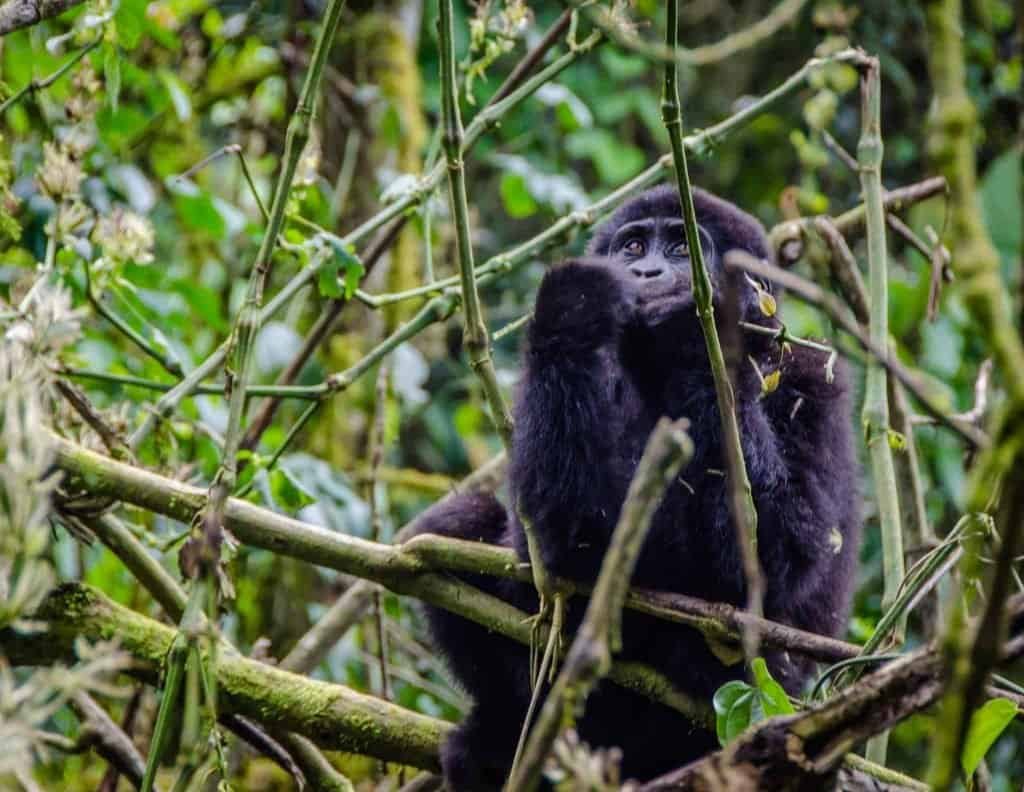This is the third and final part of the report from my trip to Uganda, you can find the first and second parts by clicking the links below:
Part One: Trip report: Kampala and Murchison Falls National Park, Uganda
Part Two: Trip report: The Wild West of Uganda
Queen Elizabeth National Park
Originally called Kazinga, this national park is the second-largest in Uganda and changed its name in 1954 following a visit by, you guessed it – Queen Elizabeth. Along with Murchison Falls National Park, QENP offically opened in 1952 and is an absolute must on any Ugandan itinerary.
In my opinion there are three distinct reasons to visit: game drives, naturally, and a boat trip on the Kazinga Channel but there is one more that many people overlook…the utter beauty of the crater landscape in an area that demands a sturdy vehicle and a good driver – but rewards the intrepid.
I was fortunate to have both a very sturdy vehicle and a very good driver – and one who knew the appeal of taking the “Crater Route” before meeting up for the boat trip.
Unmissable views – that most visitors miss
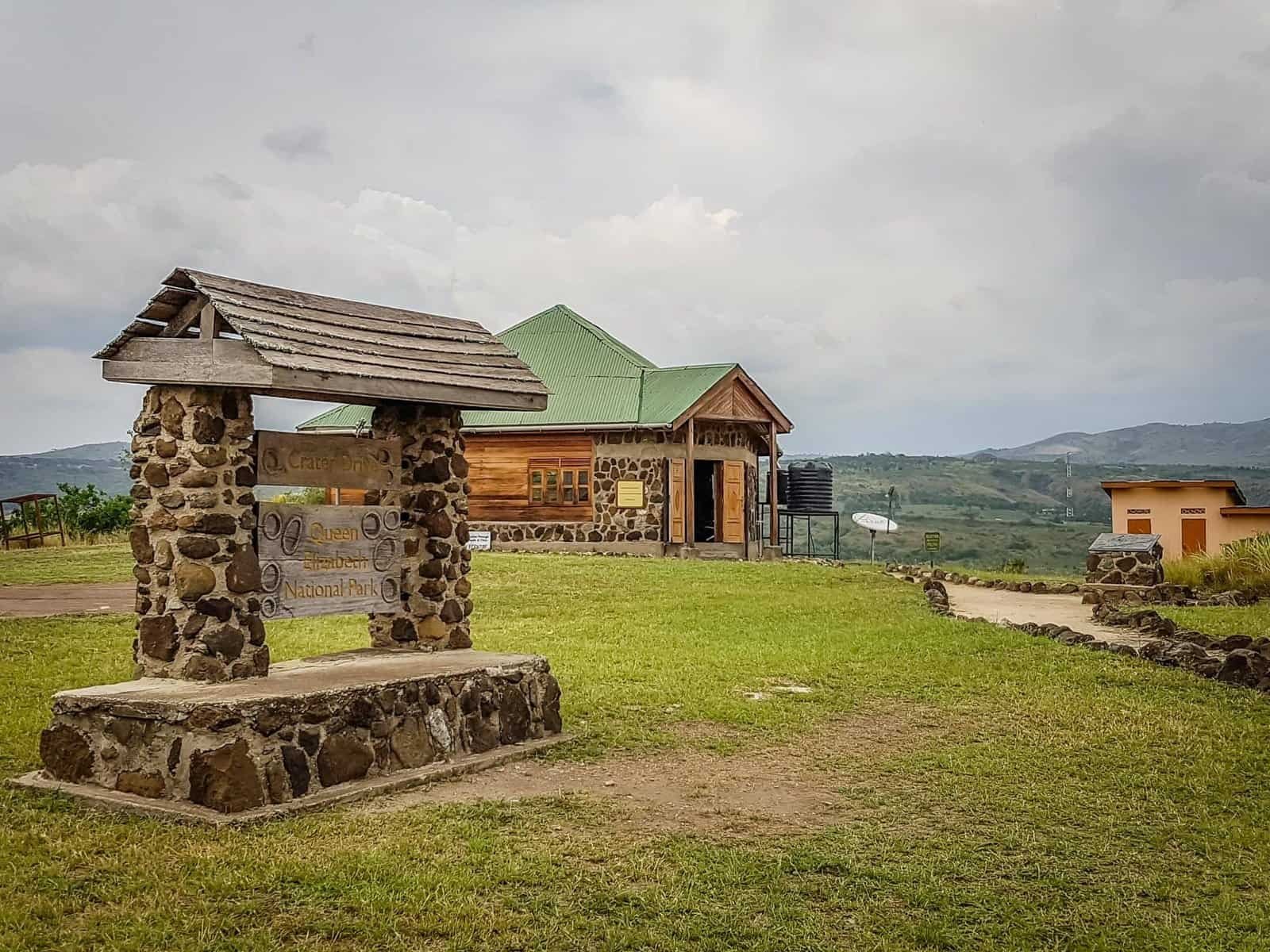
We turned off the main road through the park and passed the “Queen’s Pavilion” – originally built to receive the Queen Mother and then Queen Elizabeth and Prince Philip a few years later, now a coffee shop run by a local community group – then turned onto Crater Drive.
This is a rough track and is extremely steep at times – 4WD is absolutely essential. Most people drive straight to the lowland areas to spot wildlife but believe me, this should be an obligatory detour. The full drive is just under 30km of challenging trails and it is a good idea to allow 2 hours, given the number of times you will want to get out and stare in awe at the views. Like this:

It is hard to fully convey the scale of these craters with photos alone, but you get some idea.
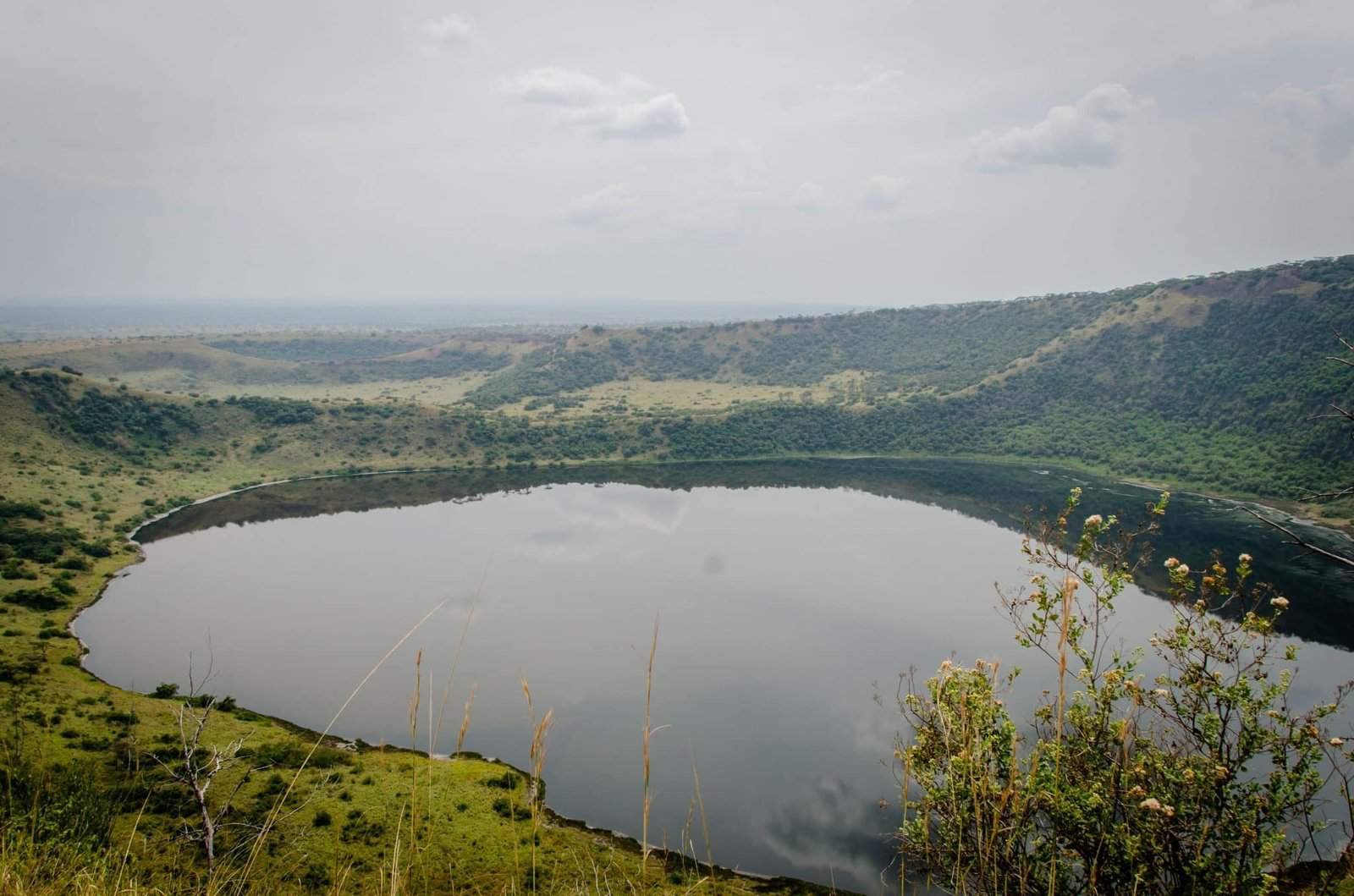
This one is filled with water that looks attractive but reeks of sulphur…
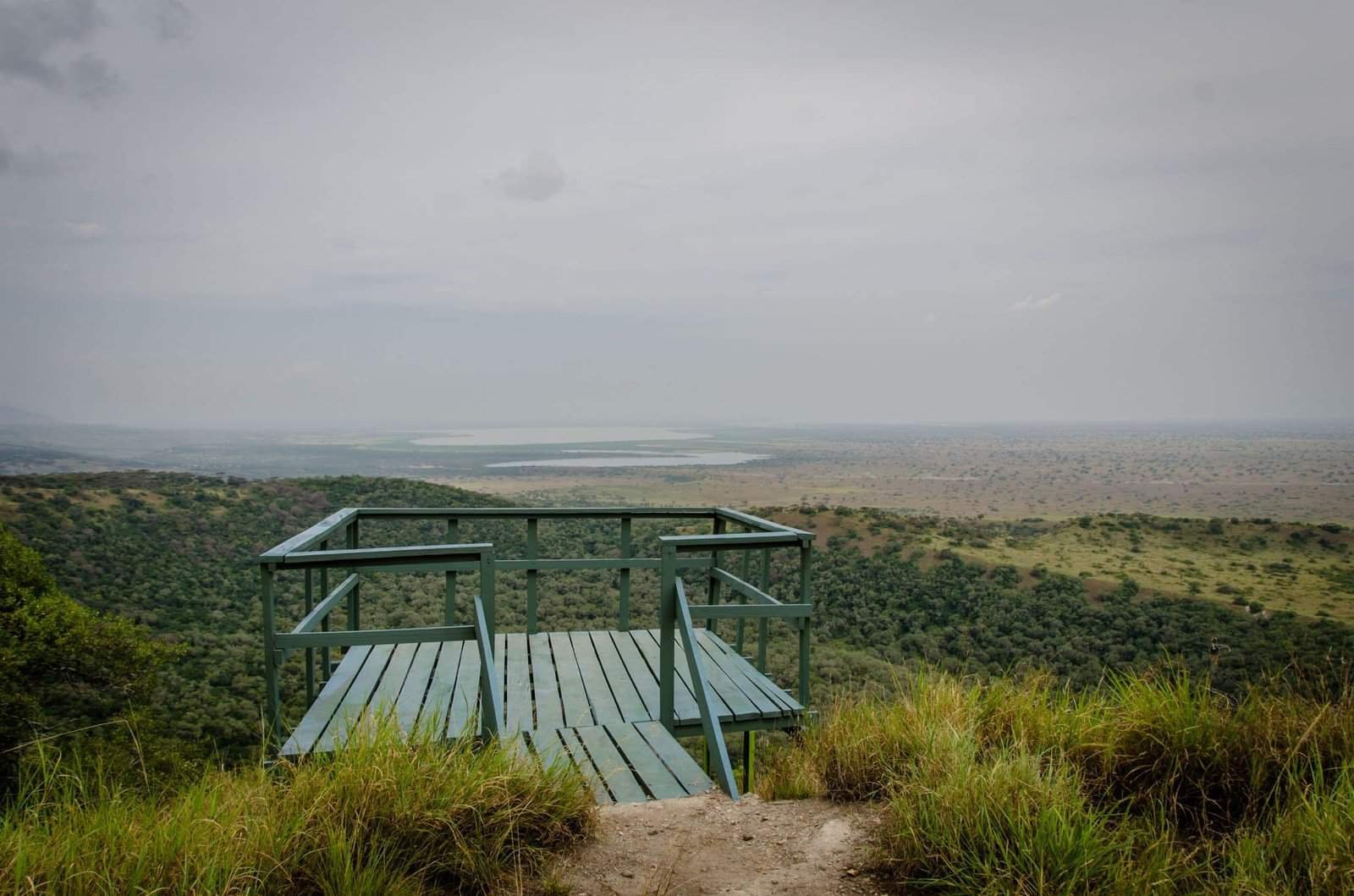
Another has thick forest on its floor, and a handy viewing platform to peer below.
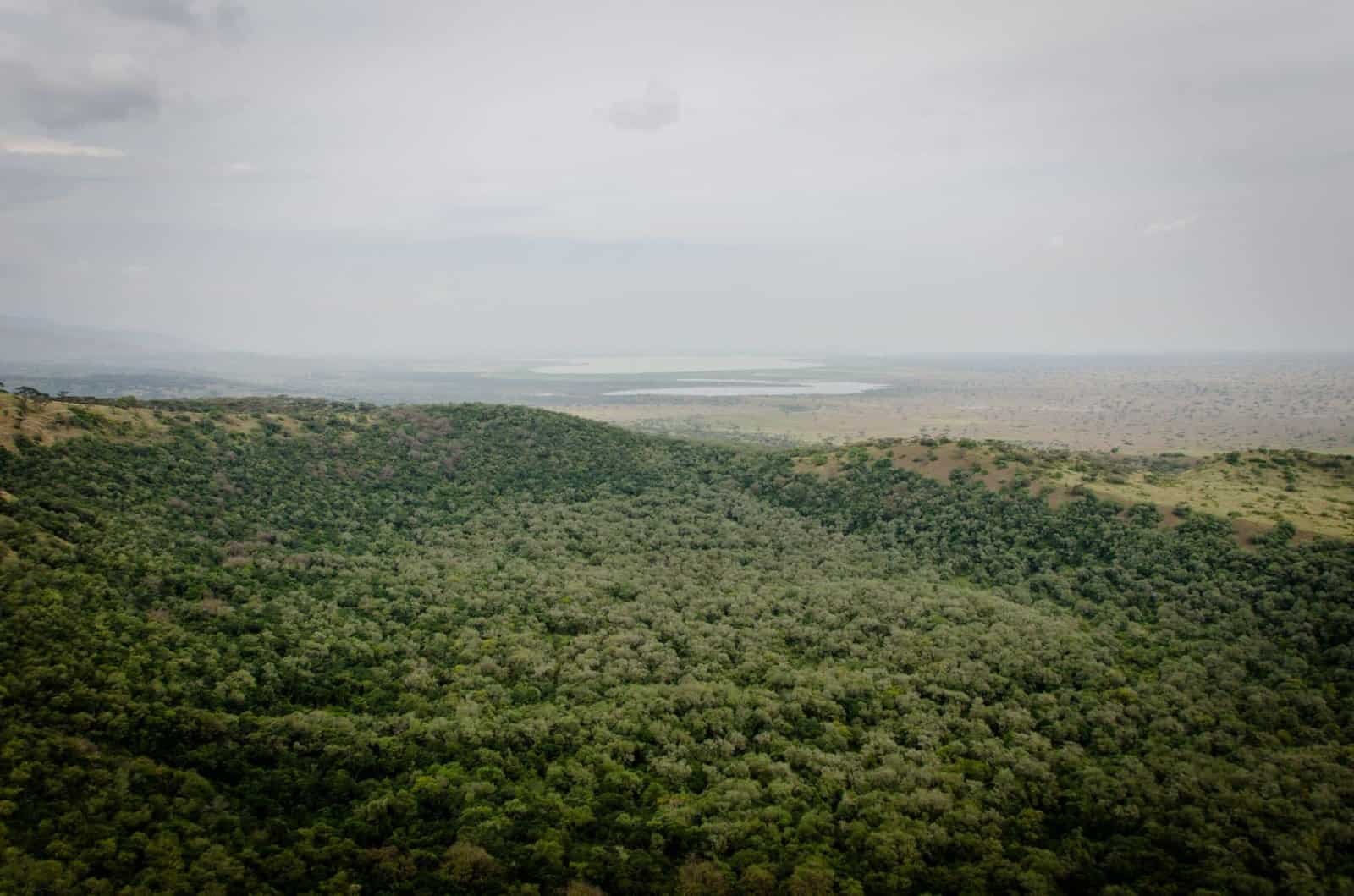
Apparently there are a lot of animals in there and plenty of predators, but it is basically inpenetrable (and likely highly dangerous) for humans.

Other craters have open grassland on their floors and we spotted elephants wandering around far below.
It was a thrilling journey and finished up near the main gate, but we had a little more time to kill so we headed west to a once-thriving salt town.
Katwe
Along the way we passed long abandoned stores and houses – once the homes and businesses of Uganda’s Asian community who were expelled from the country by Idi Amin.
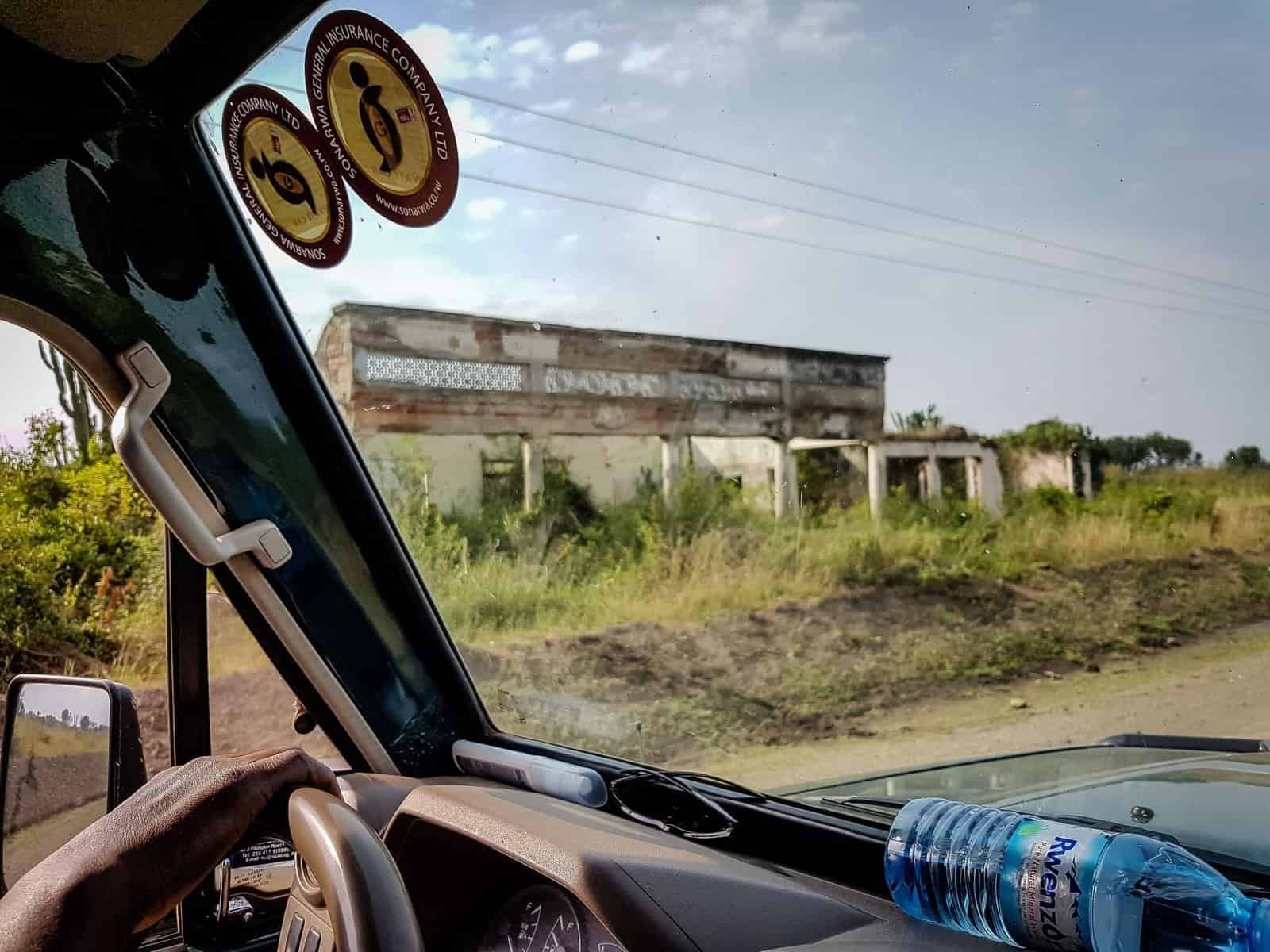
It was a sombre reminder of a dark time in Ugandan history.
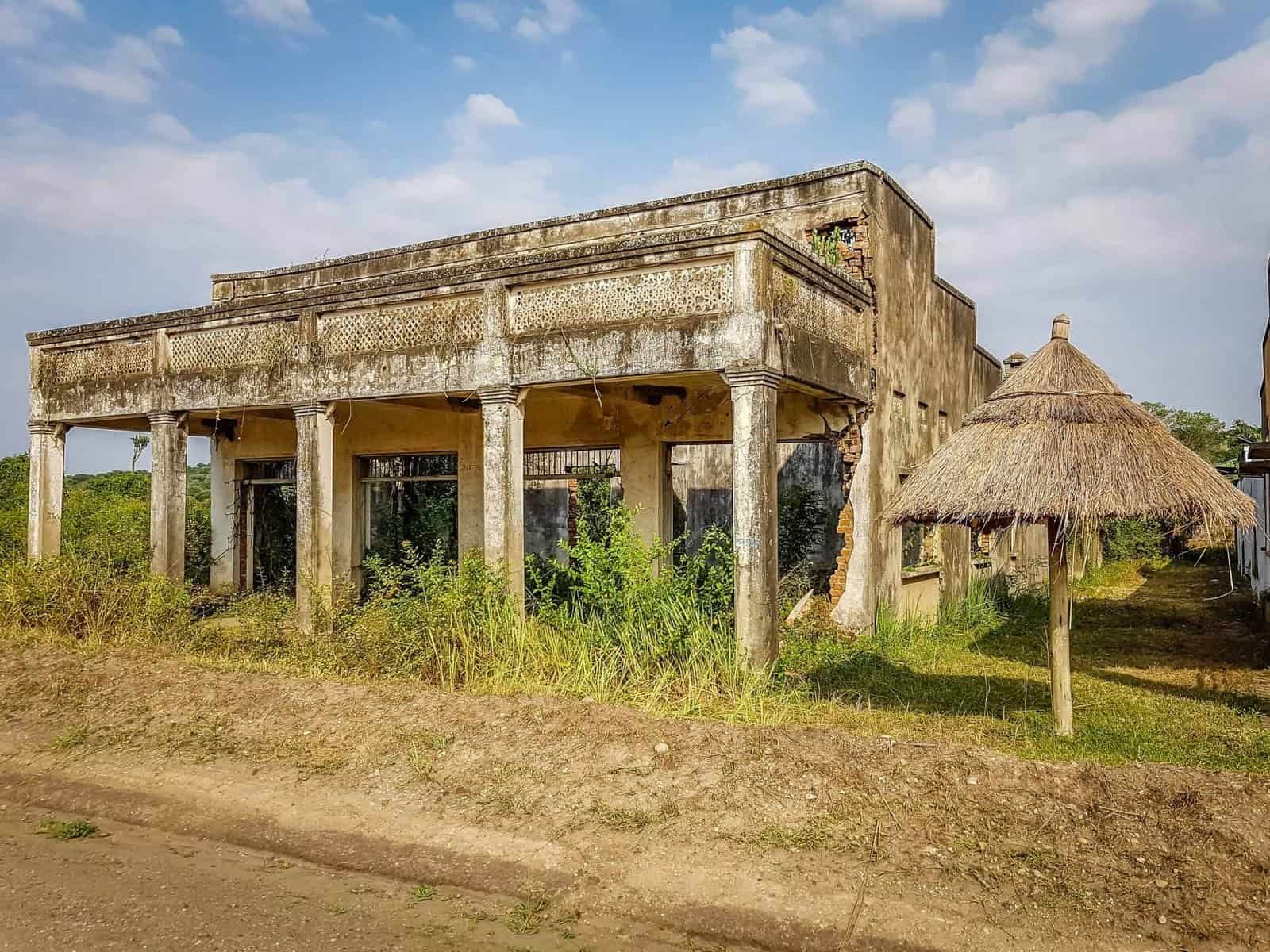
While quite a number of exiled Asian Ugandans have returned in recent years, there would be little to attract the original owners of these properties back these days.
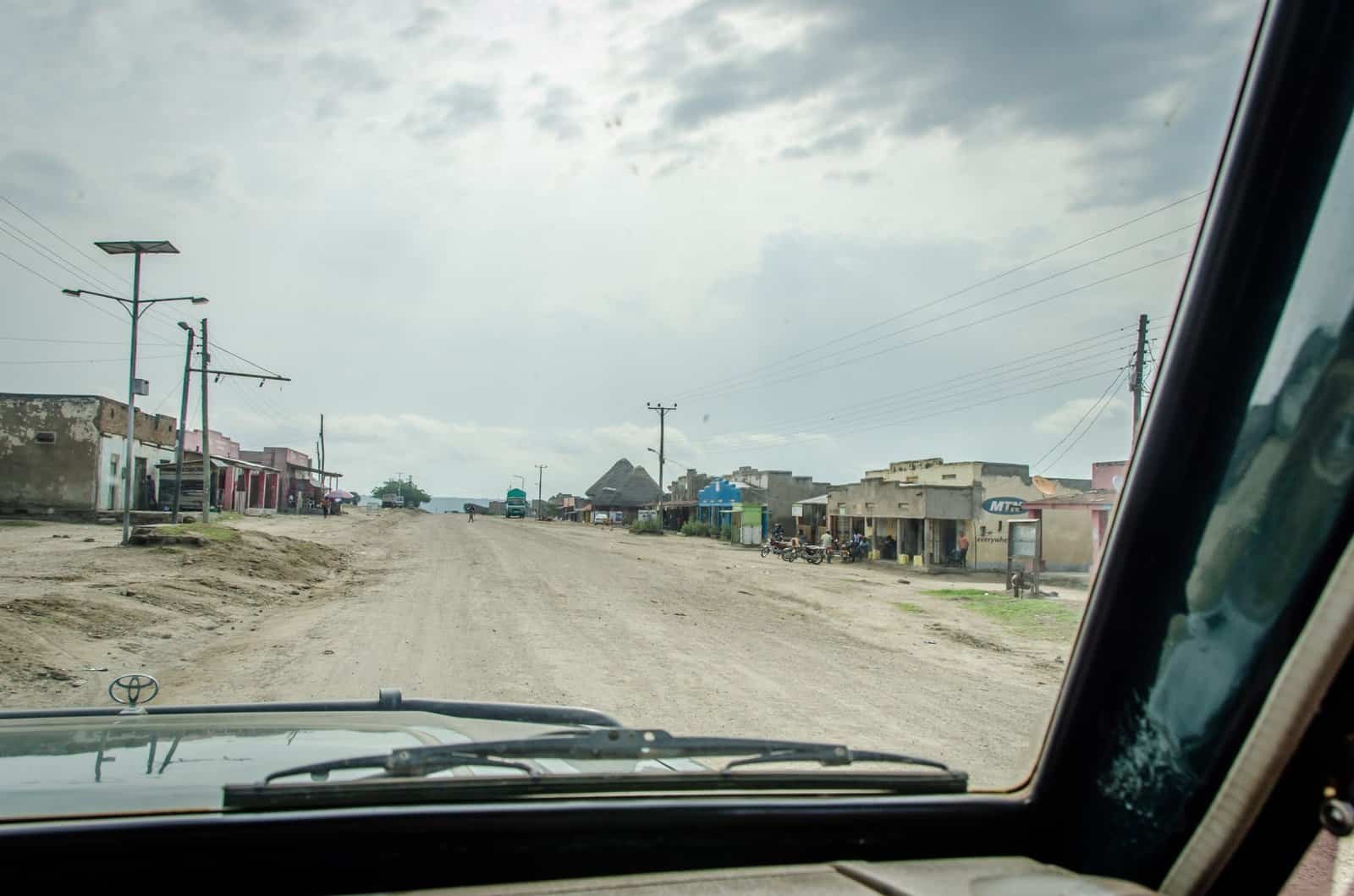
The formerly prosperous salt-mining town of Katwe has fallen on hard times.

We managed to drive right down to the massive salt lake at the end of the road, which has been the country’s most important source of coarse salt for over 500 years.

A large plant was built in town to commercially harvest the salt in the 1970s but the engineers hadn’t taken account of just how corrosive the lake waters were – the massive pipelines were soon rendered useless.
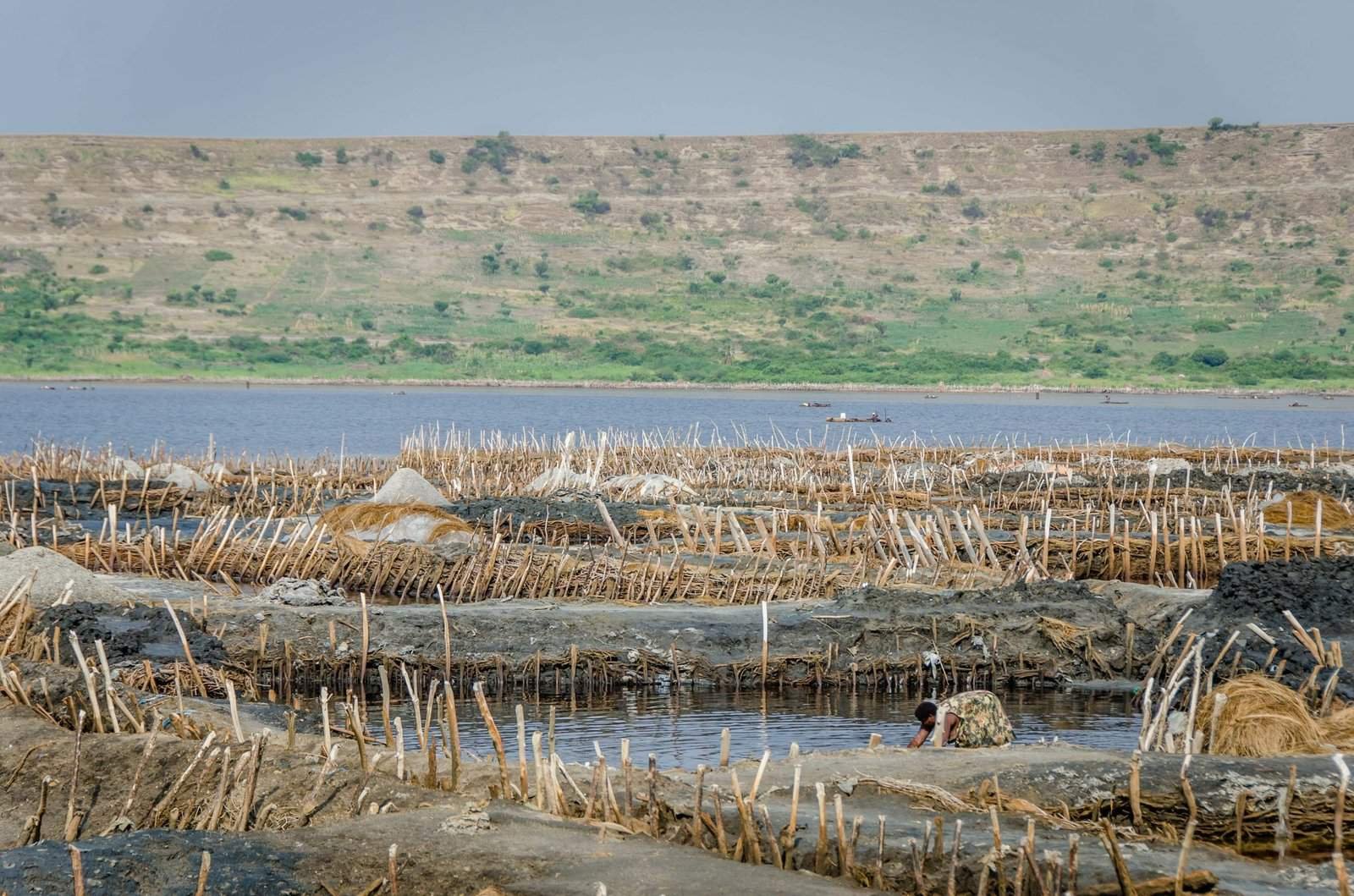
Small-scale salt extraction continues, but the town has gone into decline.
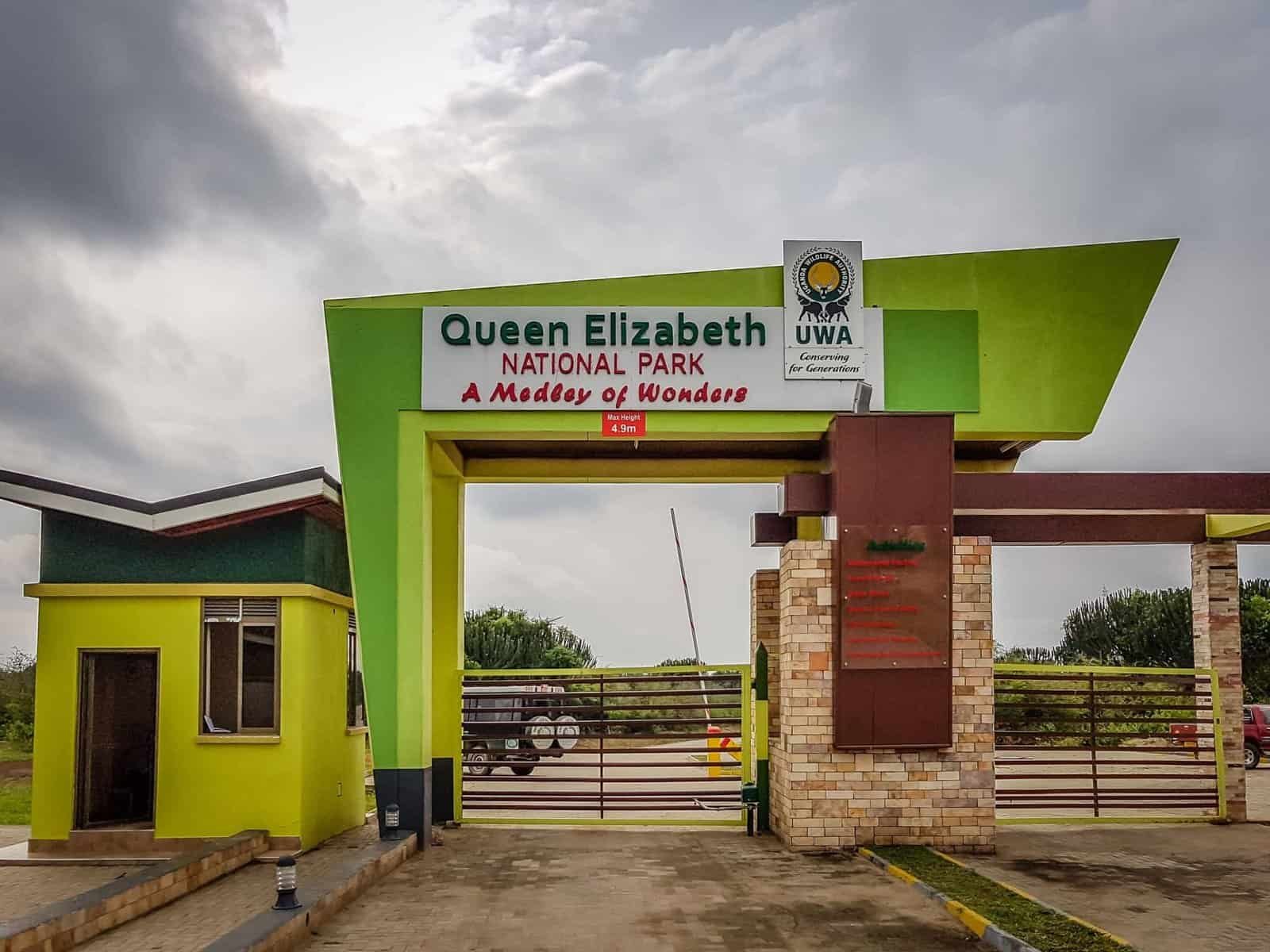
Back at the main gate Alfred completed the usual formalities of signing in and paying the entry fees (these will all be included in your tour price so you don’t need to worry about them here or in any other park on your itinerary).
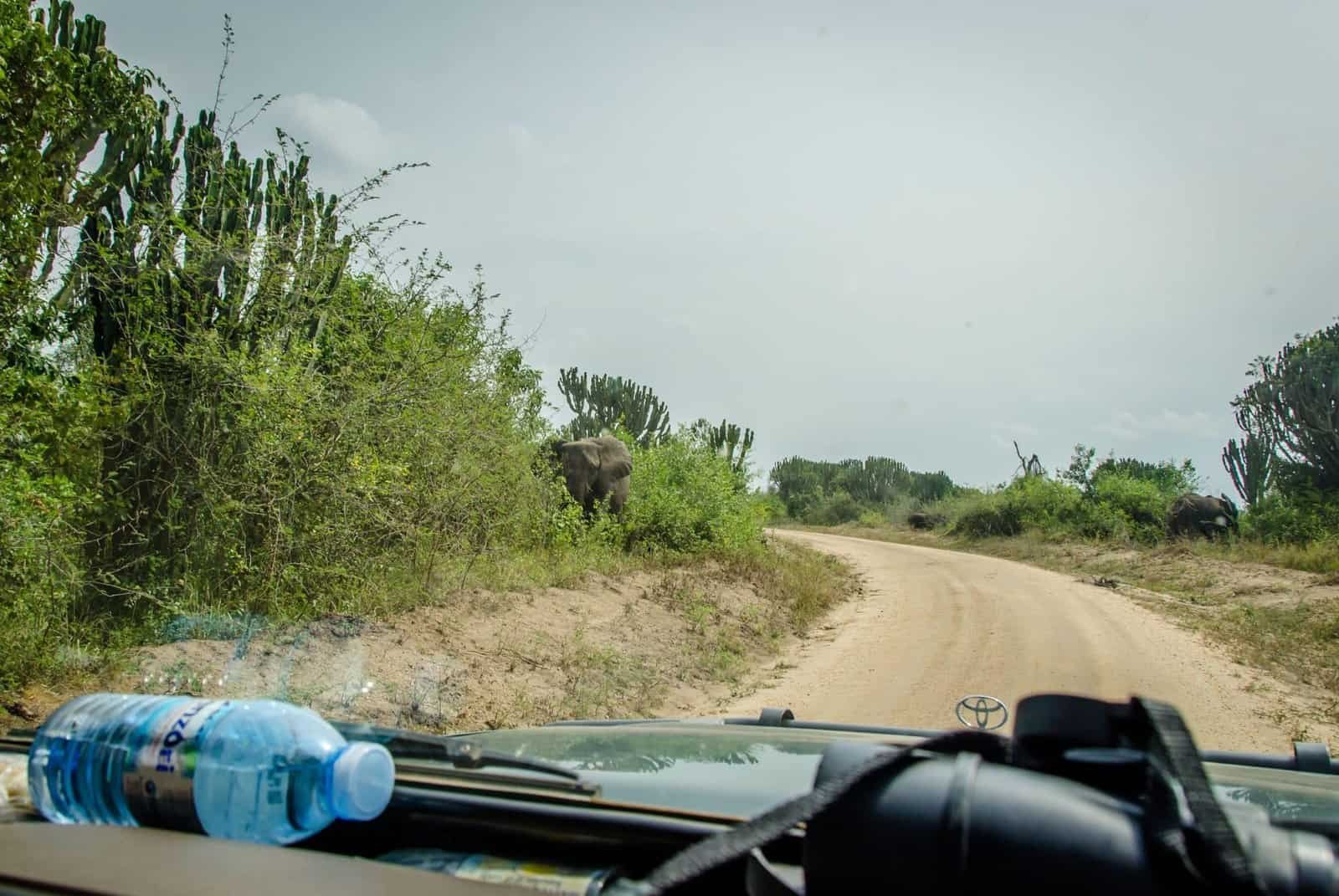
This area of the park along the bank of the Kazinga Channel has a lot of wildlife – it took only a few minutes before we had to stop to let a family of elephants cross the road…
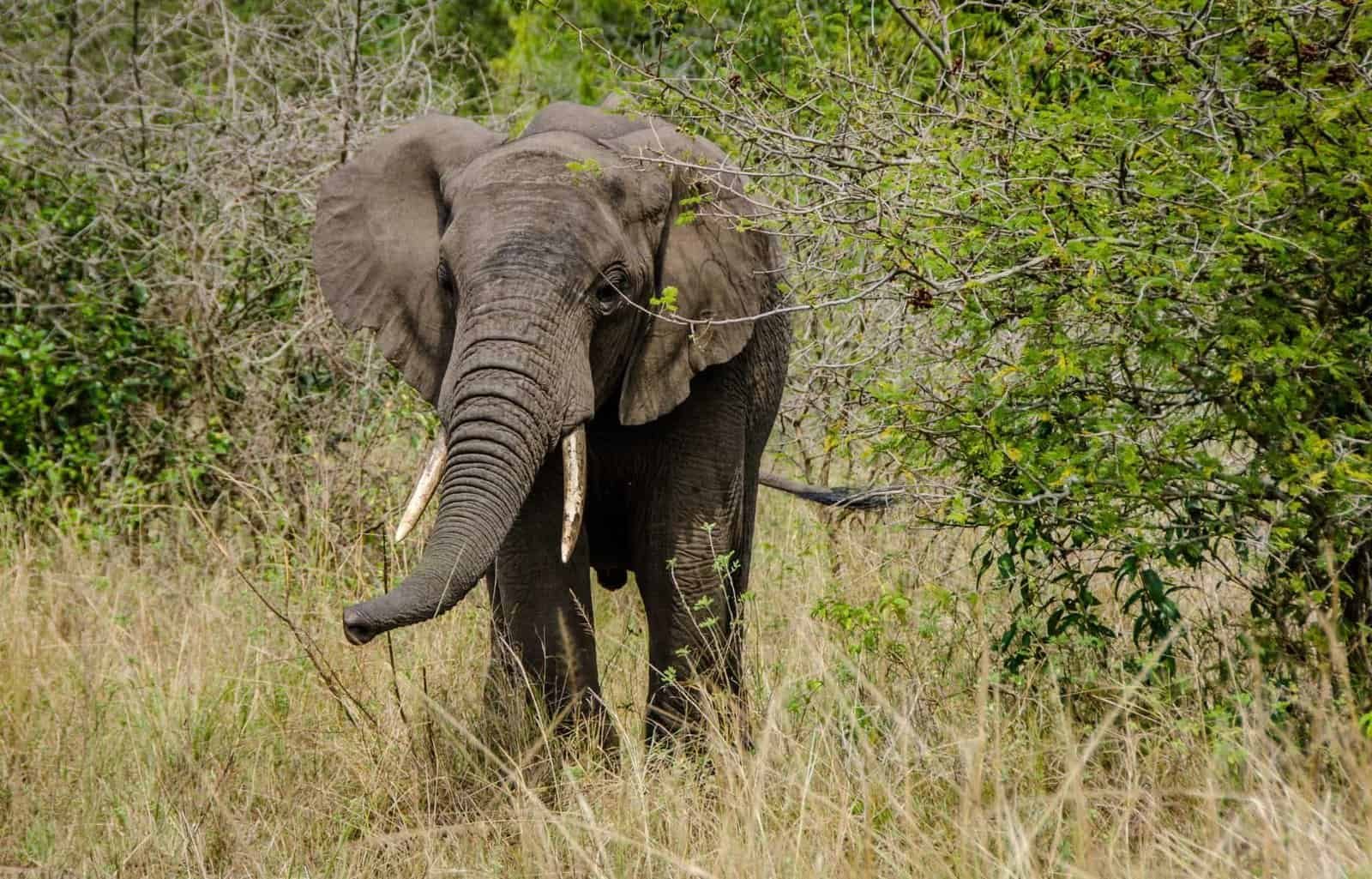
One of them gave us a close inspection before deciding we were of little interest.
Kazinga Channel boat cruise
There would be time for a proper game drive later – our next destination was the Mweya Safari Lodge from where you can organise a boat trip along the Kazinga Channel , a 33km long natural canal that joins Lake Edward with Lake George. Some two to three kilometres at its widest, it is a popular tourist attractions.
We signed in and drove down to the jetty for the scheduled boat ride.

This was a fun trip, which although lacking the spectacular waterfall of Murchison Falls, offered good game viewing as we made our way down the 12km route to the vast Lake Edward which separates Uganda from the Democratic Republic of the Congo at this point.

Uganda is famously heaven for birdwatchers, and QENP is one of the best places for twitchers.

I couldn’t even begin to remember all these types but you get an impression of the variety, at least.
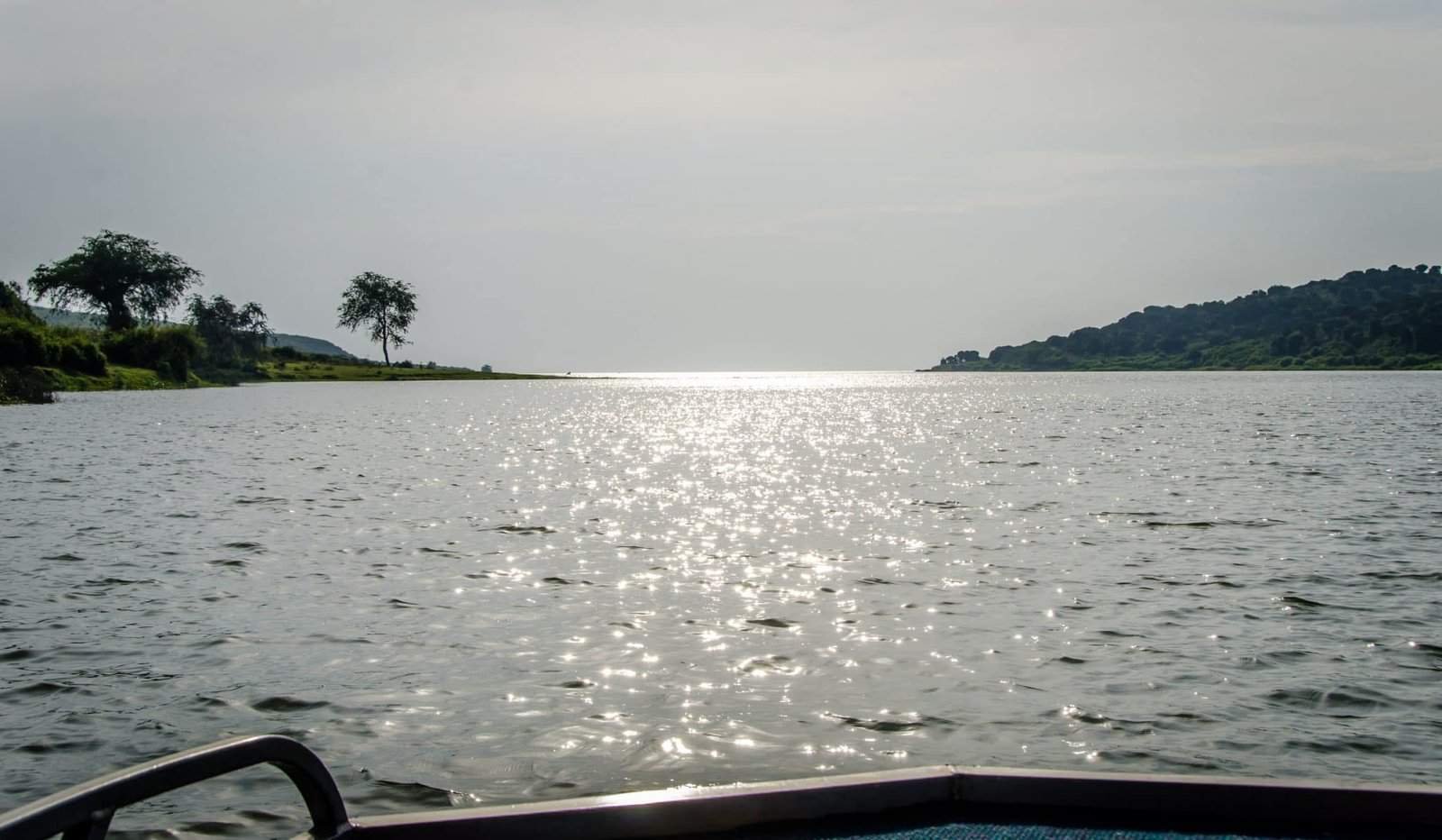
As the channel opened on to the lake we were joined by local fishermen.
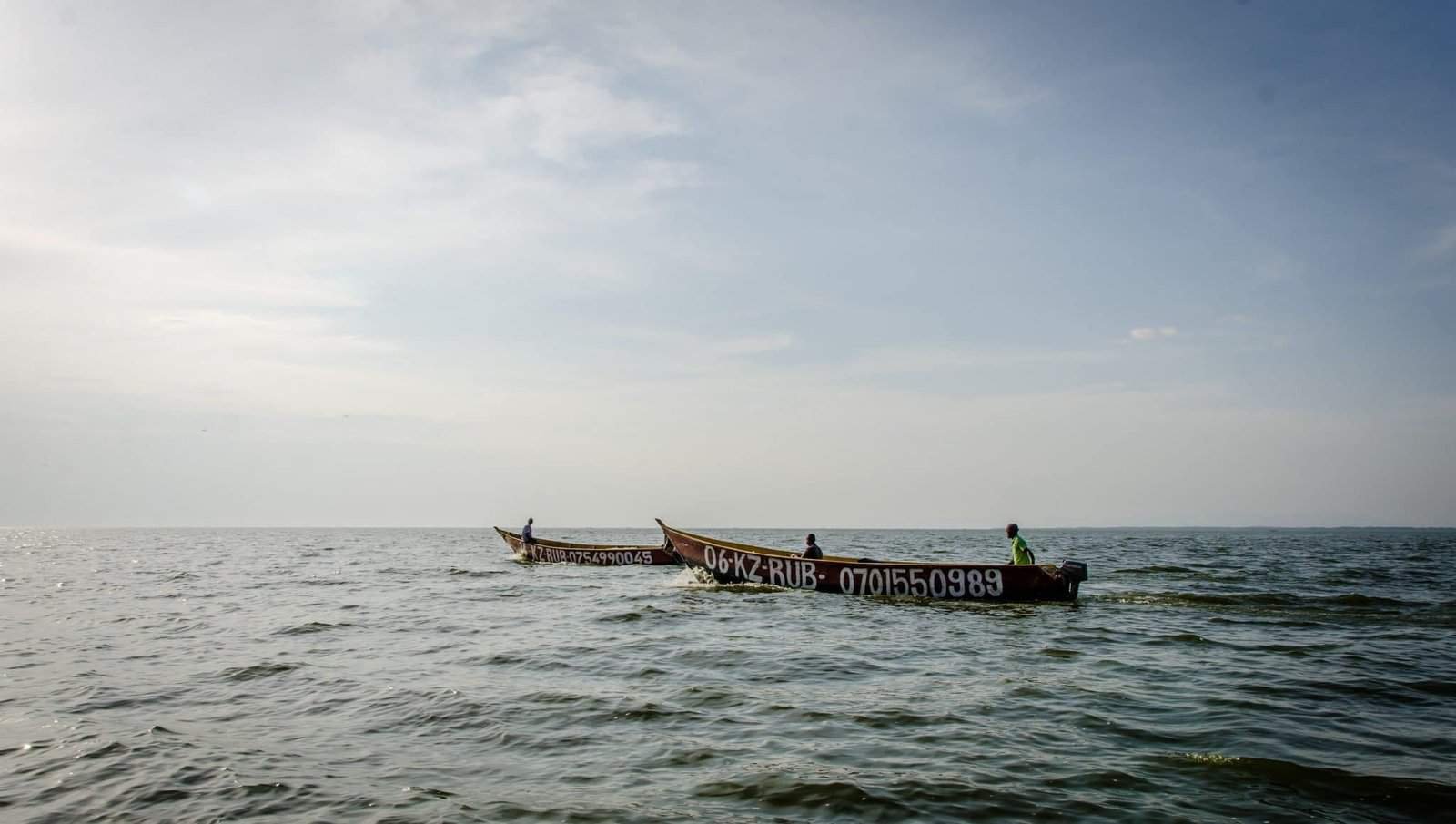
The border runs through the middle of the lake and it’s about 50km from here to the Congolese shoreline.

As well as huge numbers of hippos and buffalo, we saw a lot of very big Nile crocodiles. Cute, eh?

After returning to dry land we took a final game drive in the area, encountering yet more elephants – this time in the middle of their bathtime..

Just a few hundred metres up the road we found this lady, which was a beautiful end to the day. On our way out of the park we got a fine send-off from – yes, you guessed it – another ellie.

We drove back to Elephant Plains in time for dinner and my encounter with some uninvited and inwanted guests in my room.
After my disturbed night I was a little grumpy when the alarm went off, but this was quickly cured by a hearty hot breakfast, great coffee and some laughs with Alfred.

We said goodbye to Elephant Plains, jumped in the trusty Land Cruiser, crossed the equator again and headed back into Queen Elizabeth National Park again, this time continuing over a historic bridge and into the southern sector.
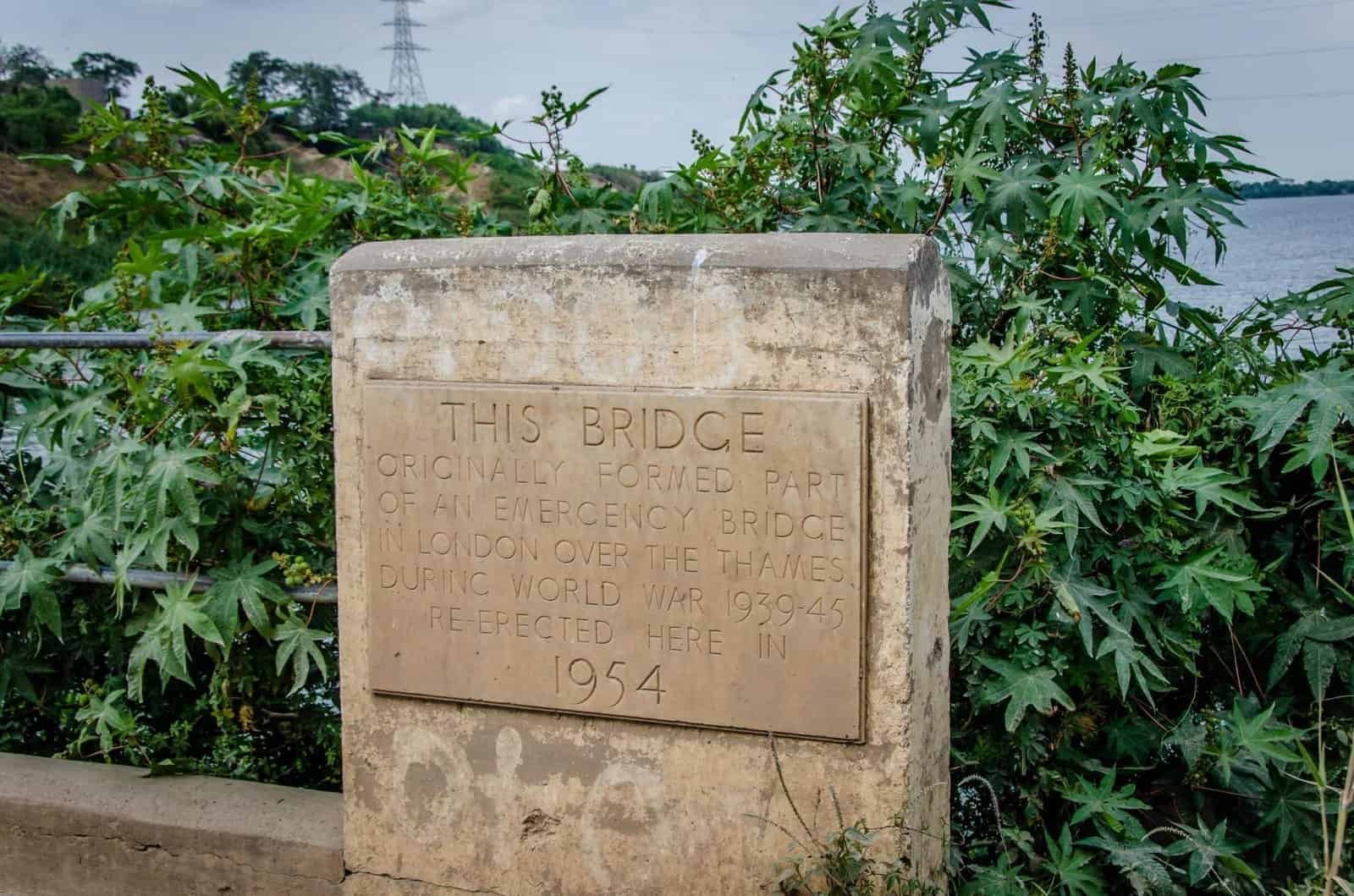
I wasn’t expecting to see this in Africa.
Ishasha
Ishasha is far removed from the Kazinga area and right on the southwestern edge of QENP. It is a relatively small area with only one main game drive circuit, but if you are lucky you can see its famous tree-climbing lions. This is by no means guaranteed, and indeed luck was not on our side this time.
However, Ishasha did provide us with a spectacular sighting – actually one of the best I have ever had in Africa.
First of all we found what was clearly a leopard kill in the branches of a tree – but no leopard.
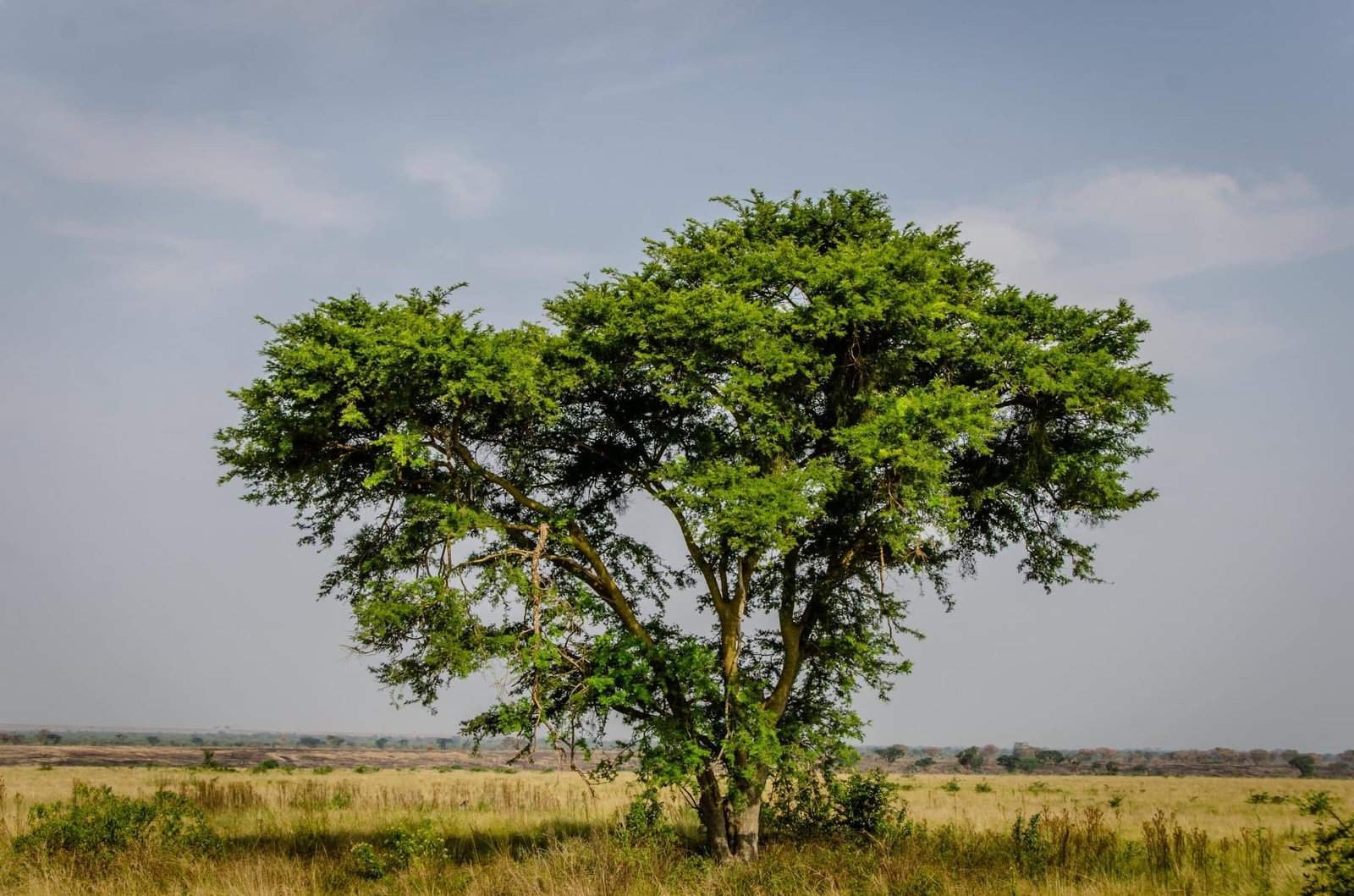
Then Alfred spotted something up high some distance away while scanning the area with binoculars. Can you see it? Let’s get a bit closer…
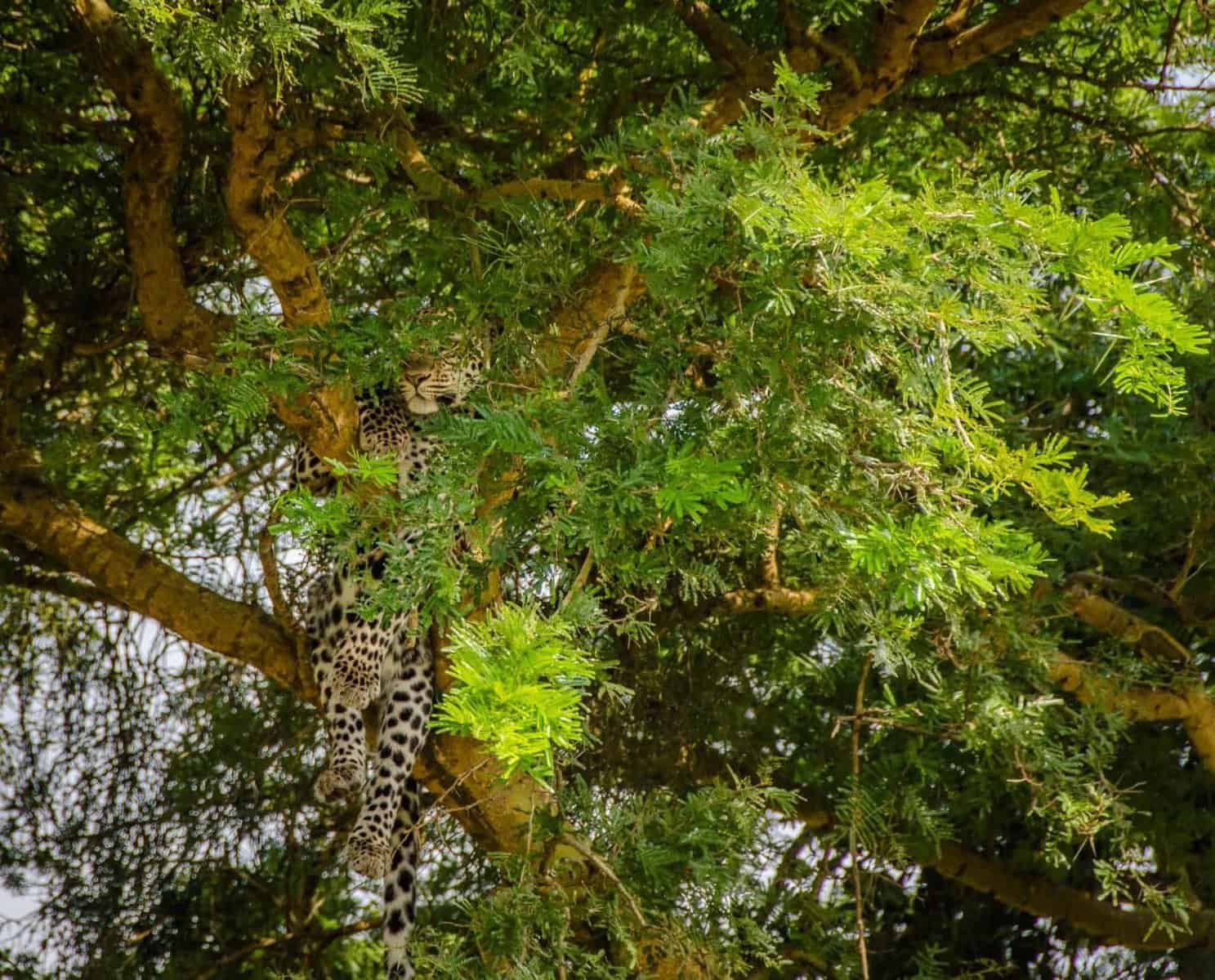
And there you have it – a beautiful leopard hanging around in the branches.
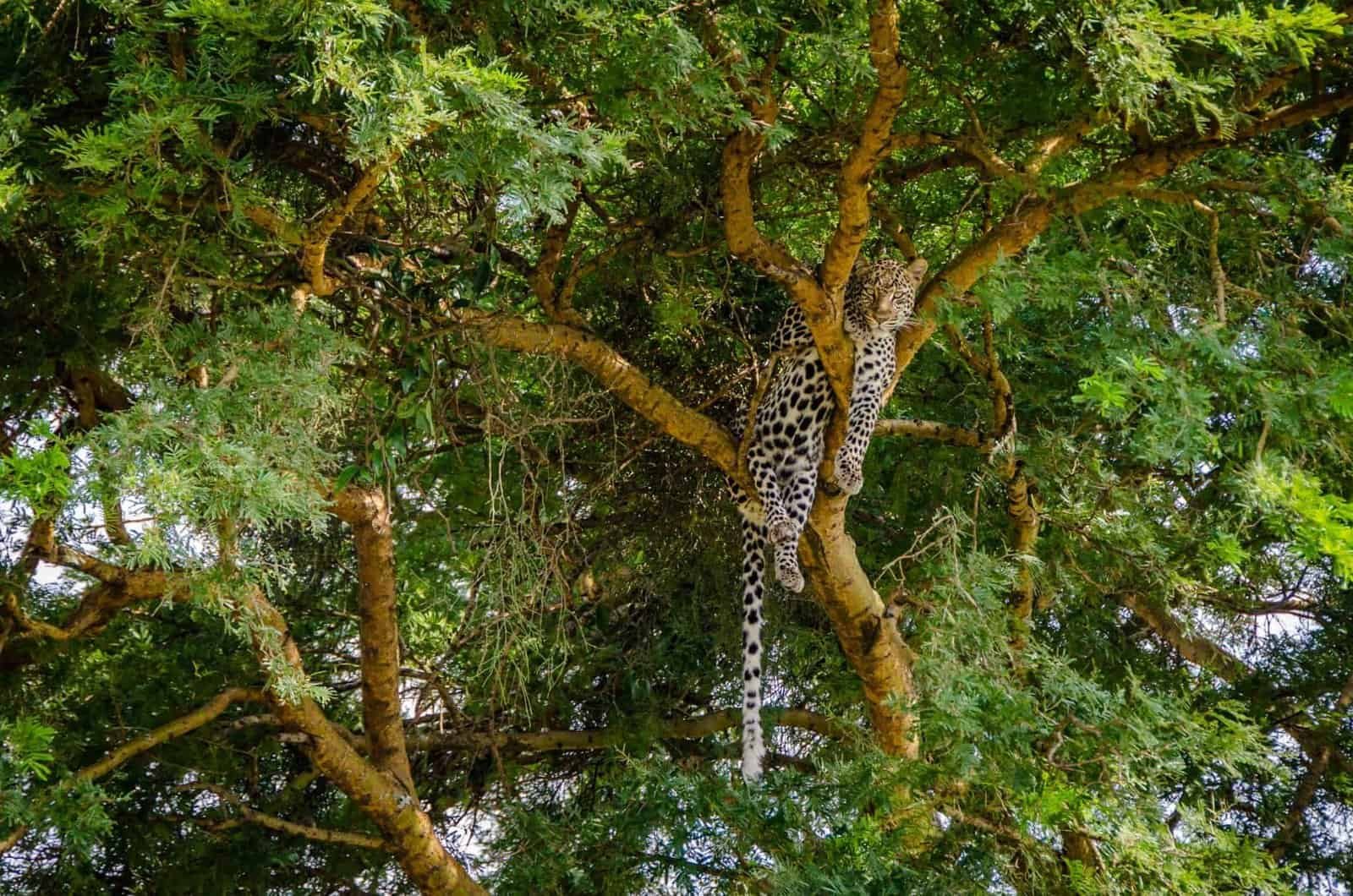
One of my favourite animals, both for their beauty and their elusiveness.

It was a real privelige to get so close and an experience I will never forget.
With that, we left QENP and travelled further south, driving parallel to the mighty Virunga mountains on the Congolese side. It was time to see if I would have better luck with the mountain gorillas than with the chimpanzees…
We arrived in the scenic town of Buhoma in the late afternoon. This is where gorilla tracking started in 1993 and is still the most popular base for the activity – probably due to its excellent range of high-quality lodges and relatively easy access.
You will need at least two nights here; one to rest up from the journey and for the next day’s hike, and the second to rest up after the experience before moving on.
On our tour we stay in a lodge in Buhoma itself, but still only a quick drive away from the trailhead for gorilla tracking.
Mahogany Springs

An excellent place to stay and perfect base for primate-based activities, Mahogany Springs is extremely comfortable, has excellent food, friendly staff and spacious cottages.

The reception, restaurant and bar are all located in the main building, and the cottages are reached by snaking pathways through the lush gardens.
The room
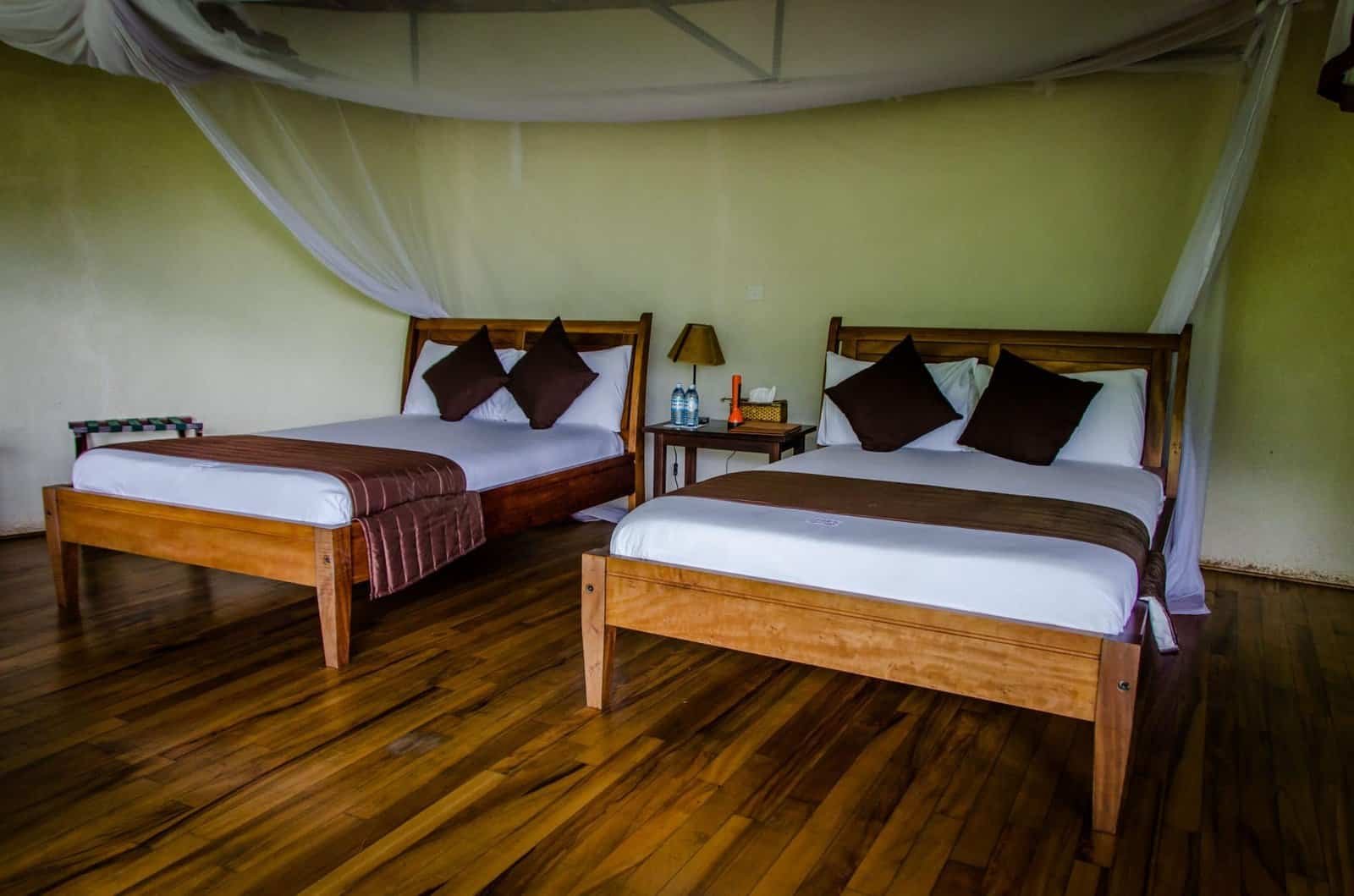
Unusually for African lodges, this time a modern, almost minimalistic design has been employed in the rooms.
Here is a video:
I liked it a lot, especially as a change from the often dark and over-furnished more traditional style of accommodation.
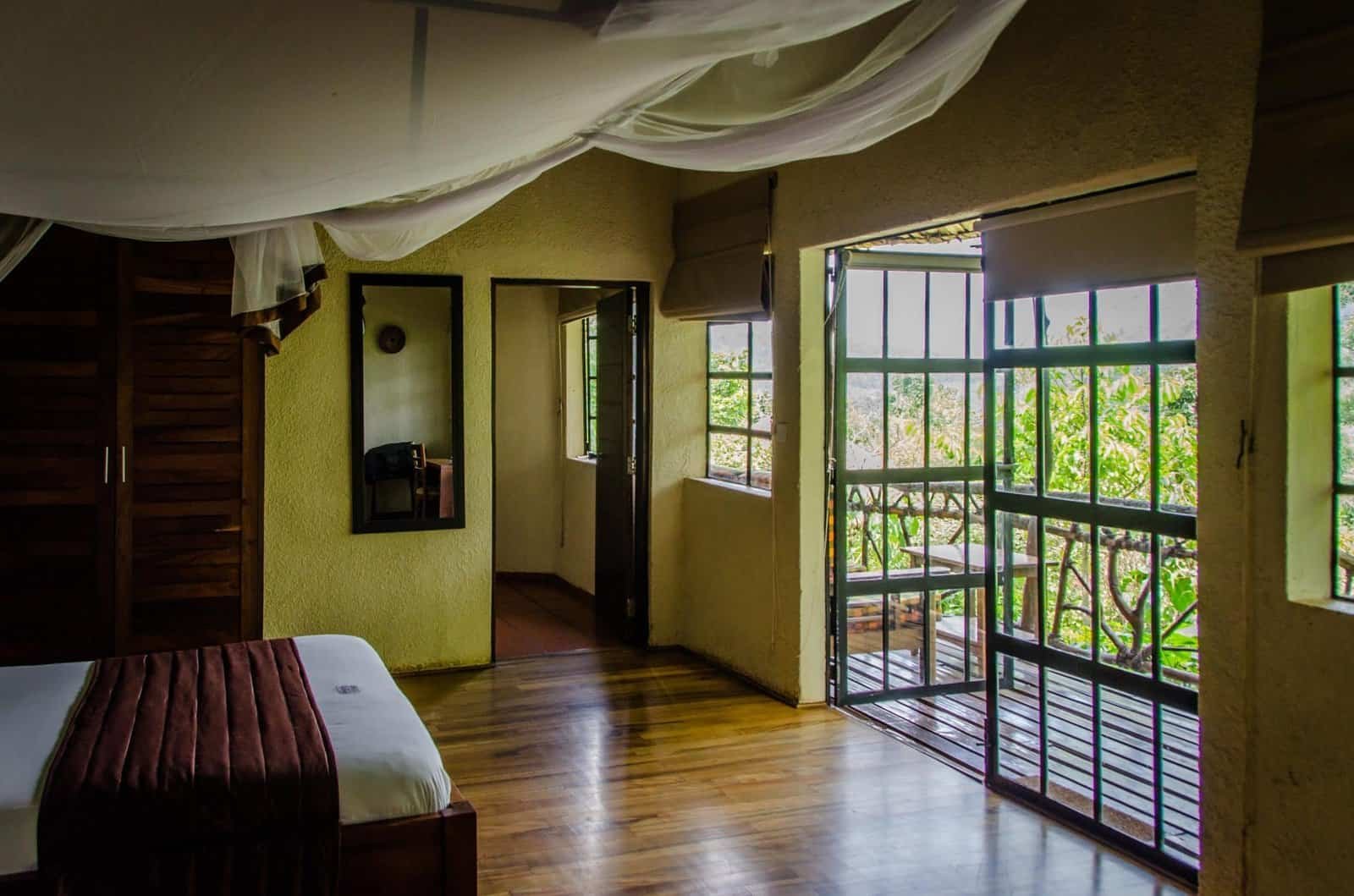
Even with two large beds there is plenty of room.
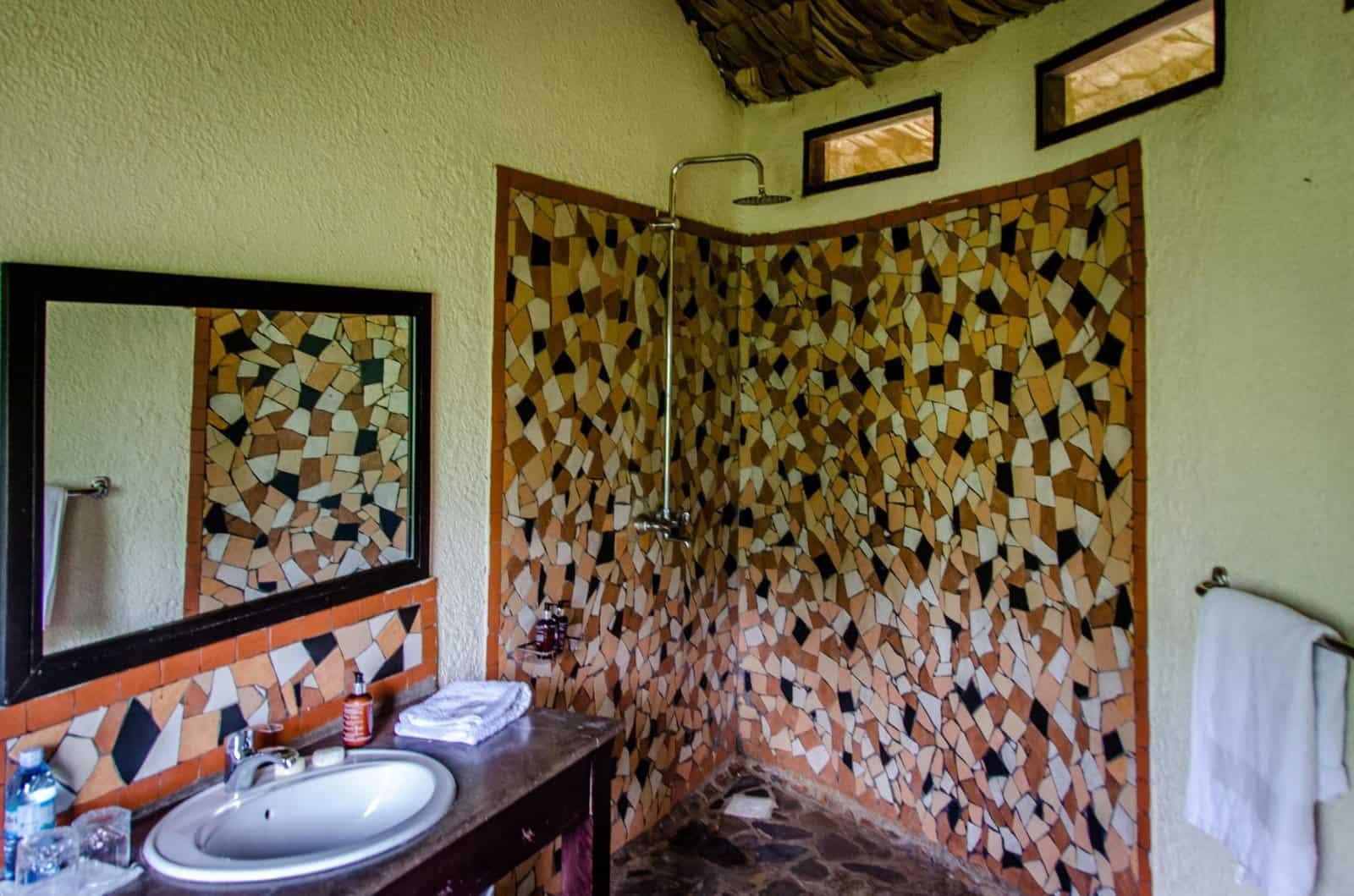
The bathroom was also large with a good shower and all toiletries provided.

The view from the terrace was very picturesque and I spent a happy couple of hours on mine editing photos and relaxing.
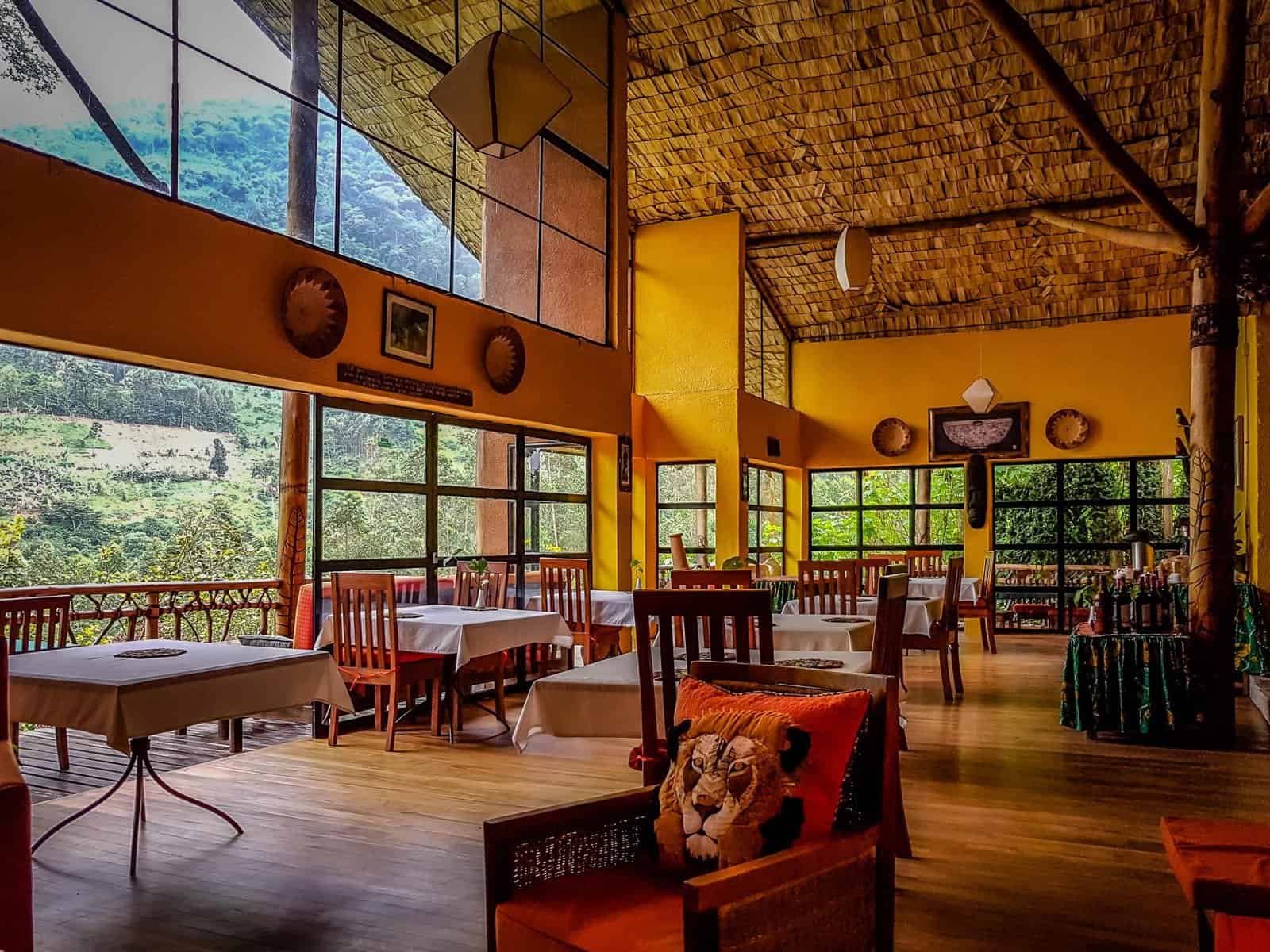
The bar and restaurant area was nicely decorated and the lounge area featured a wood-burning fire which was welcome as the nights turn chilly at 1500m above sea level in a damp valley next to a rainforest…
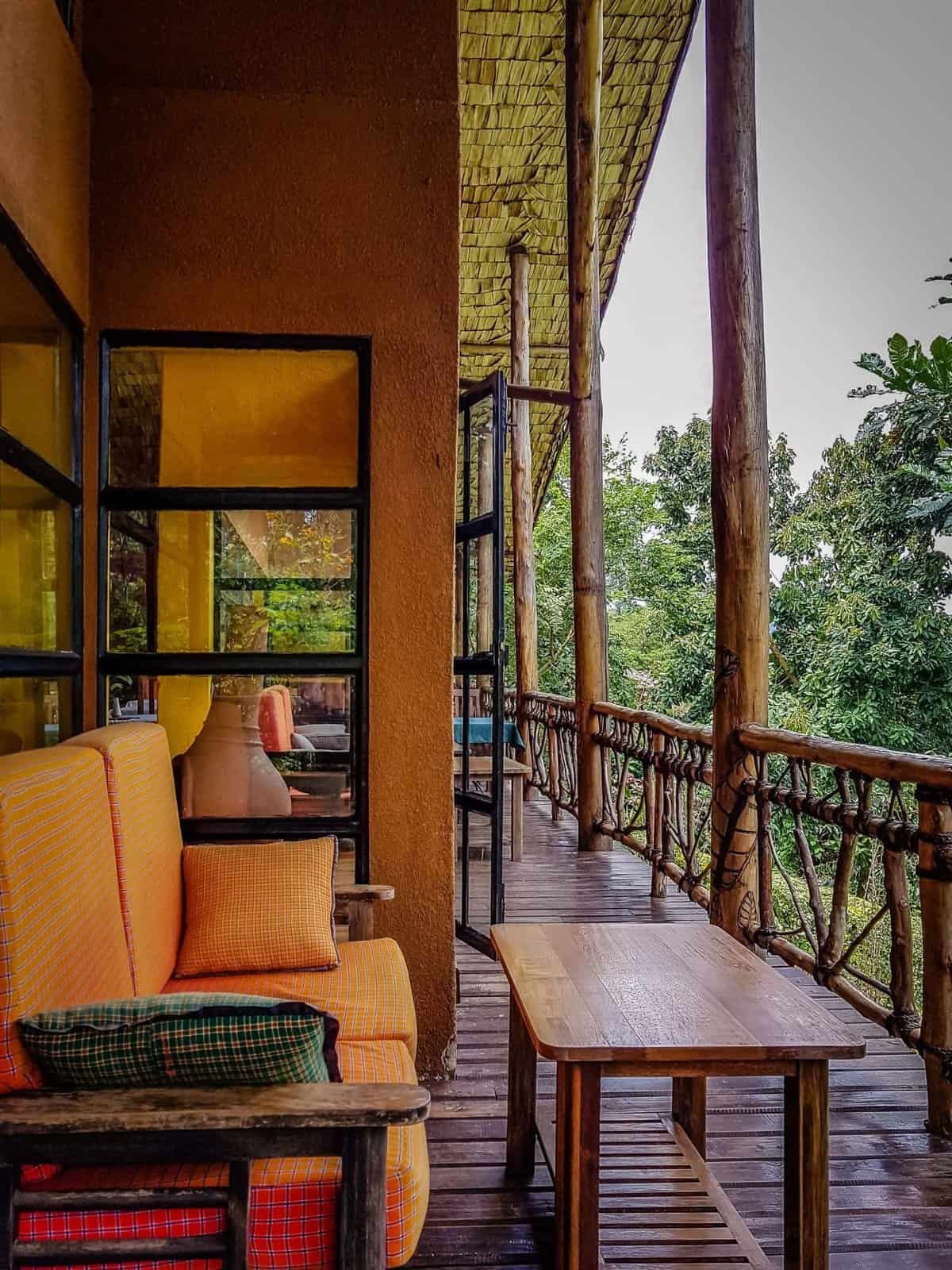
There is also seating outside – the perfect place for a sundowner. Dinner was very good with a range of options on the menu. On my first night I retired early and fell asleep almost instantly, dreaming of what the next day would have in store for me.
Gorilla Tracking in Bwindi Impenetrable National Park
The rather fabulously-named Bwindi Impenetrable National Park is home to the rare and critically endangered mountain gorillas. The forest itself, dating back to the ice ages, is one of Uganda’s oldest and ecologically most diverse with almost 400 species of plants, 350 species of birds as well as 120 mammals including baboons, chimpanzees, elephants and antelopes as well as the gorillas.
I woke early and ate a big breakfast to give me some energy for the trekking ahead. You need to be at the reception building at 8 a.m. and bring your passport for registration. Again, your tour operator will have arranged the permit which is an optional extra – at present the cost is USD 600 per person but as of July 2020 the cost will rise to USD 700. It’s a lot, but it’s the experience of a lifetime and still under half the USD 1500 you have to pay in Rwanda.
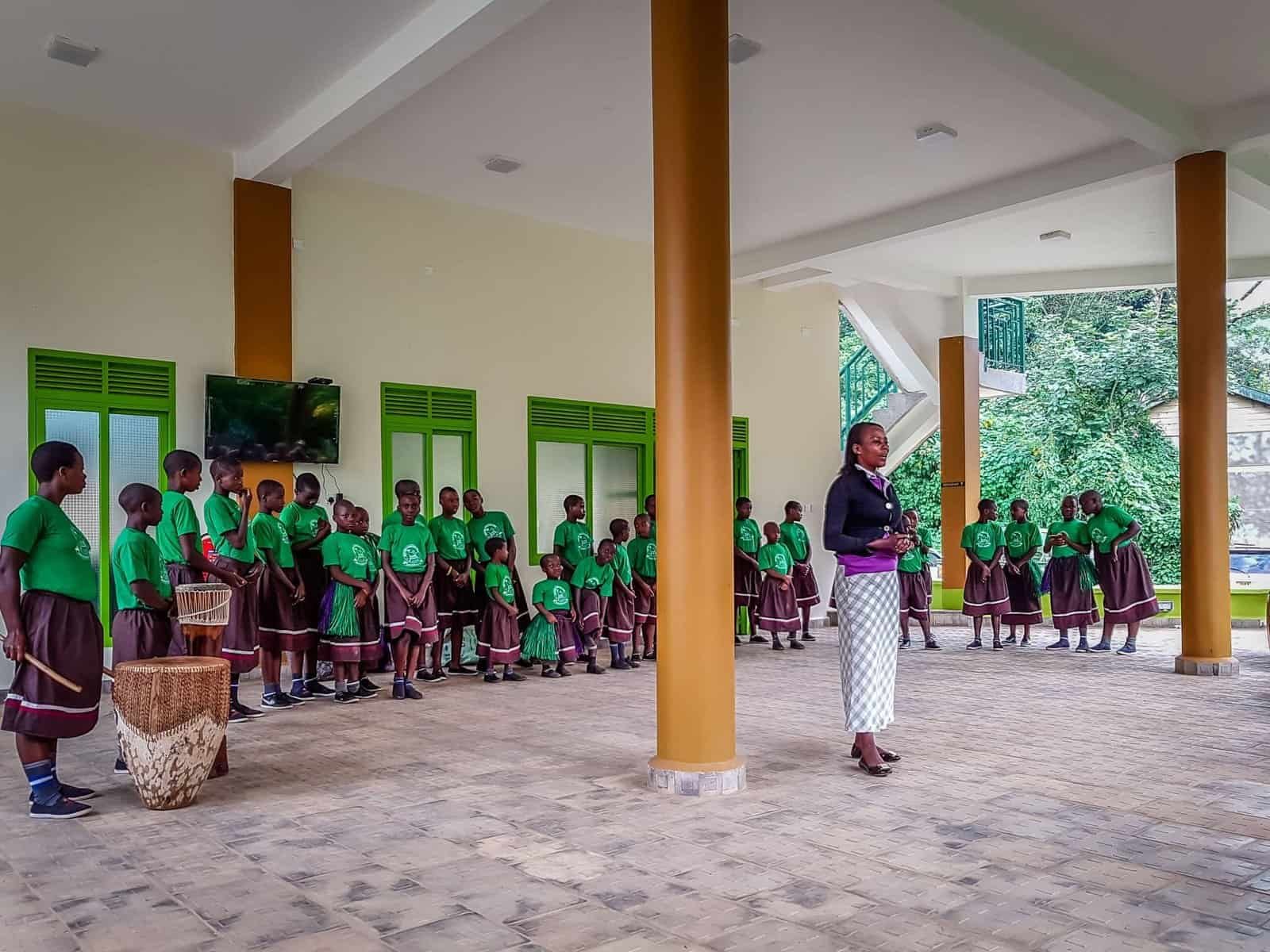
The local school put on a wonderful musical performance for us all before it was time for the briefing.

You will be given the opportunity to hire the services of a local porter for an additional fee. At first I had not planned to do so but it is an opportunity for locals to earn some money so in the end everyone had their own porter. I had a small rucsac with rainwear and a couple of cameras and was very glad to have help on the way.
You will need proper water-proof hiking boots or shoes, a light rain coat and long trousers and long sleeved tops. Wear thick into which you can tuck the legs of your trousers to stop anything getting into your boots. Most lodges (including Mahogany Springs) provide a packed lunch, water and a walking stick that comes in very handy.

After the briefing we were divided into groups and assigned our gorilla family. We could actually walk to the start of our trekking route but some other groups had to drive a short distance to theirs.
For the record, you can expect to walk long distances in steep and sometimes muddy conditions with rain overhead, which can be tough and require a degree of fitness.
At this point let me share some insight from my experience: meeting the gorillas is for many a lifetime dream, but I would advise you not to wait until you are retired to do so. One of our group almost collapsed and we we lucky enough to not have to trek too far – she was not really fit for the hike but it’s rare for visitors to be turned away so you need to make your own decision. Personally I recommend fulfilling this dream as soon as you can.

We were extremely fortunate in that we only walked for an hour and a half before we met the gorillas – it can take up to 8 hours and in a very small number of cases you may not find them at all.
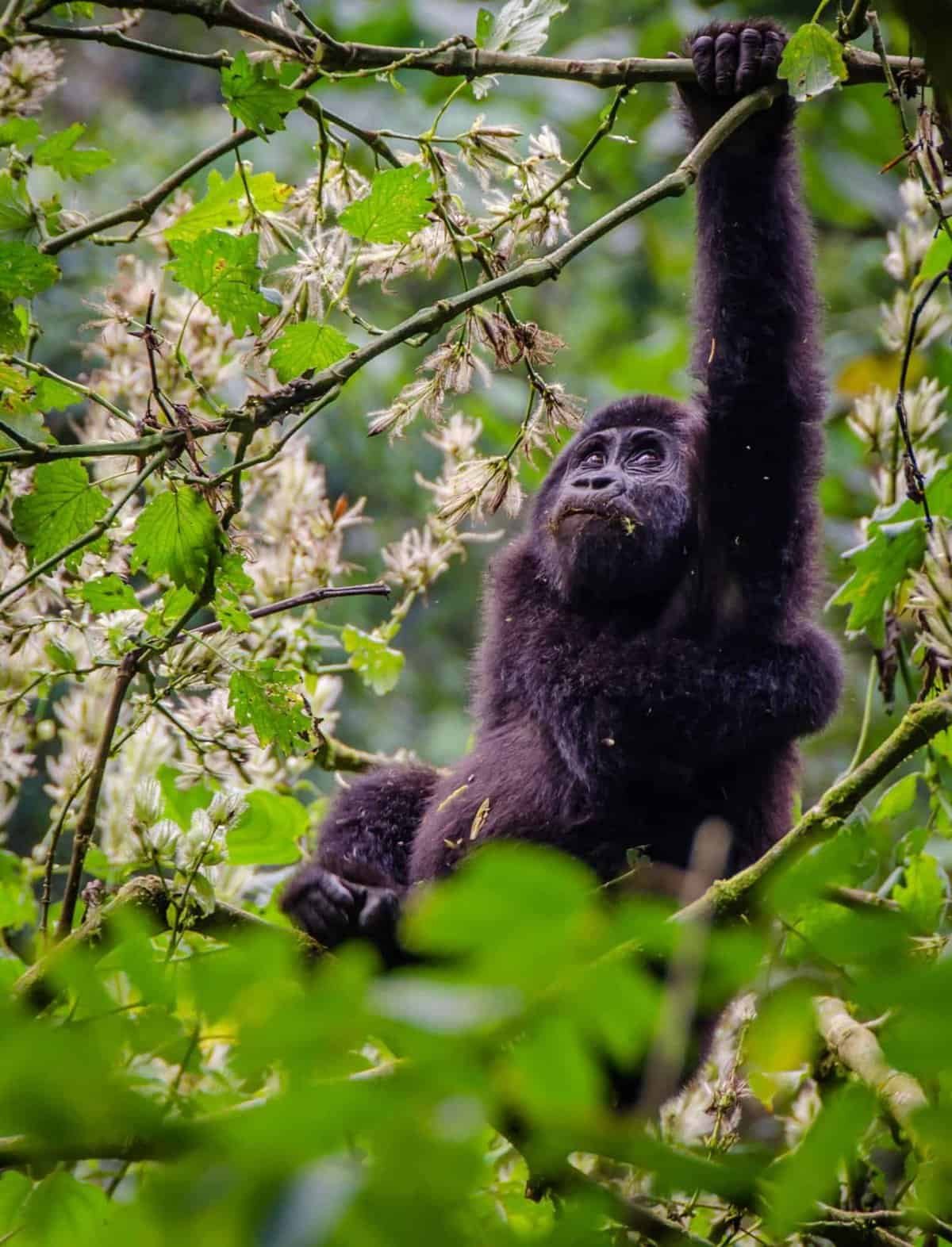
Once we found our family, we had exactly one hour with them as they went about their daily life; feeding, playing, raising their young and in the case of the juveniles, a bout of wrestling.

I took a few pictures but spent the majority of the hour just enjoying this unique and almost surreal experience, as did the majority of our group.

It truly is incredible to see how “human” the gorillas are – or how “gorilla” we are…

The sixty minutes flew past and all to soon it was time to hike back to the reception building to receive our certificate for meeting the gorillas.
After a breathtaking morning, I inspected a couple of lodges and then returned to Mahogany Springs to relax for the rest of the day.
Buhoma to Lake Mburo
After breakfast we left Buhoma for our final destination – Lake Mburo National Park. This would be my last night in Uganda and I was not looking forward to flying out the next day.
Luckily the journey soon cheered my up. It was another amazing experience – a winding gravel/clay/mud “road” that took us through miles and miles of mountains, lush valleys and seemingly endless banana plantations. Uganda really is a land of outstanding natural beauty.
Eventually we reached the tarmac road which continues all the way to Kampala, and we were soon able to travel at a more normal pace.
We stopped for lunch on the way before turning off for the last national park of my trip.
Lake Mburo National Park
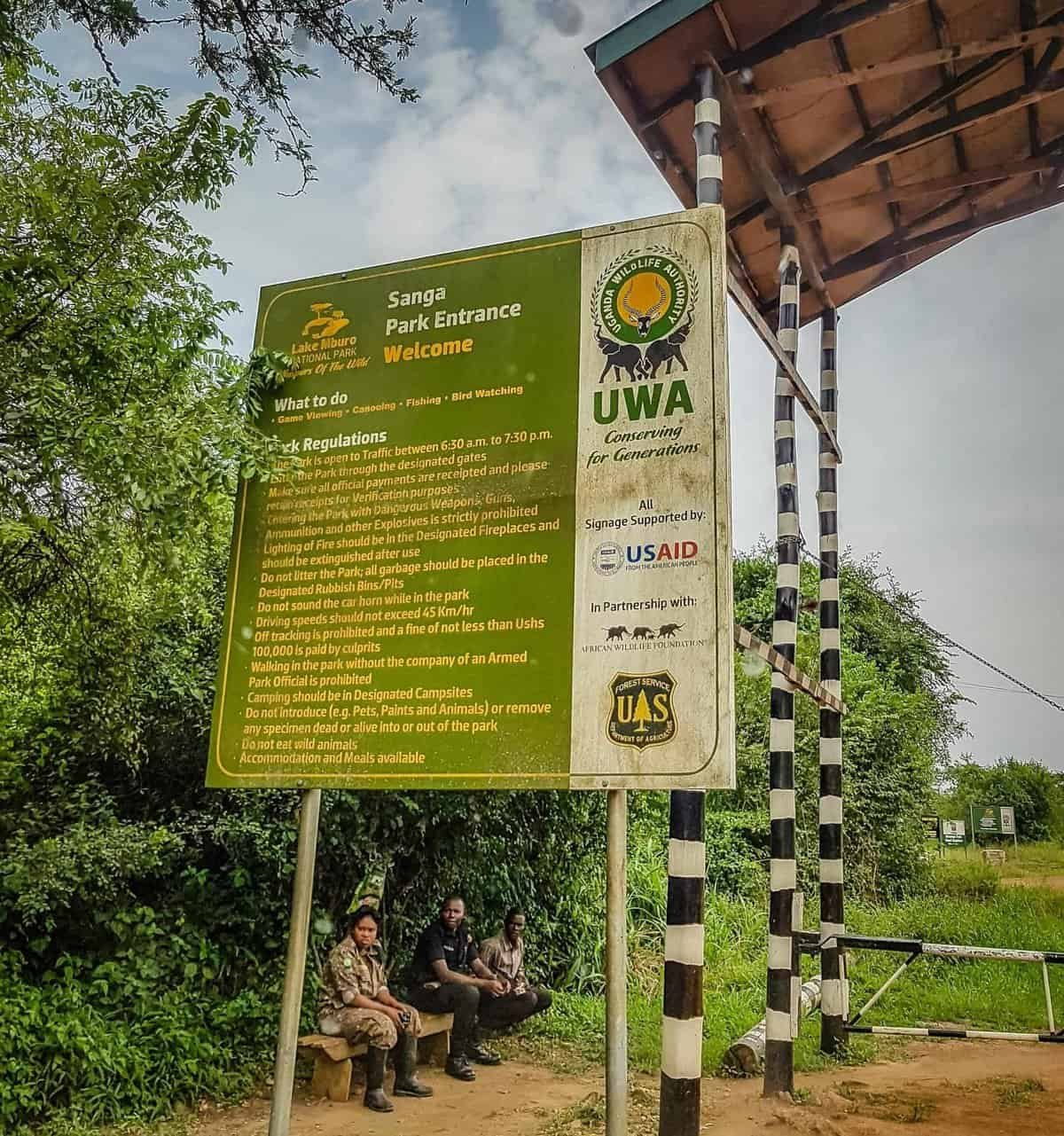
Lake Mburo National Park is one of Uganda’s smaller national parks covering “only” 260km2. Lake Mburo is the largest of the five lakes that lie within the park boundaries, all fed by the Rwizi River. The other parts of the park are predominantly covered by savannah and acacia woodland. It is the only park in the country that has a large population of impala, after which Kampala is named.
It is also one of the only three parks where the Burchell’s zebras can be found. Other animals include the ubiquitous buffalo as well as hippos, warthogs, some primates, hyenas, and other antelopes.
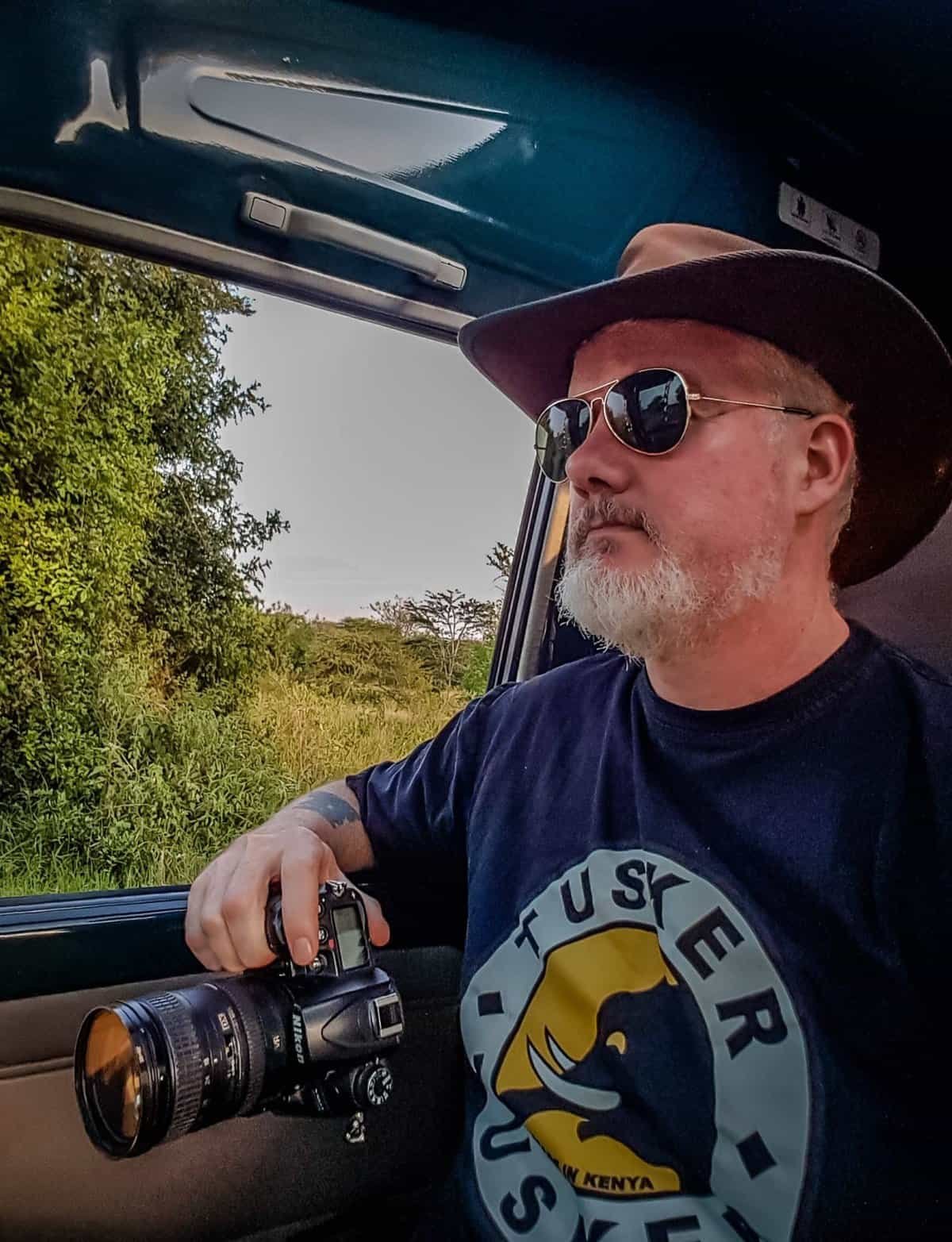
We arrived in the early afternoon so had time to explore on our own. I had my camera ready and was wearing my safari hat, shades and Tusker t-shirt – in other words, full game drive uniform.
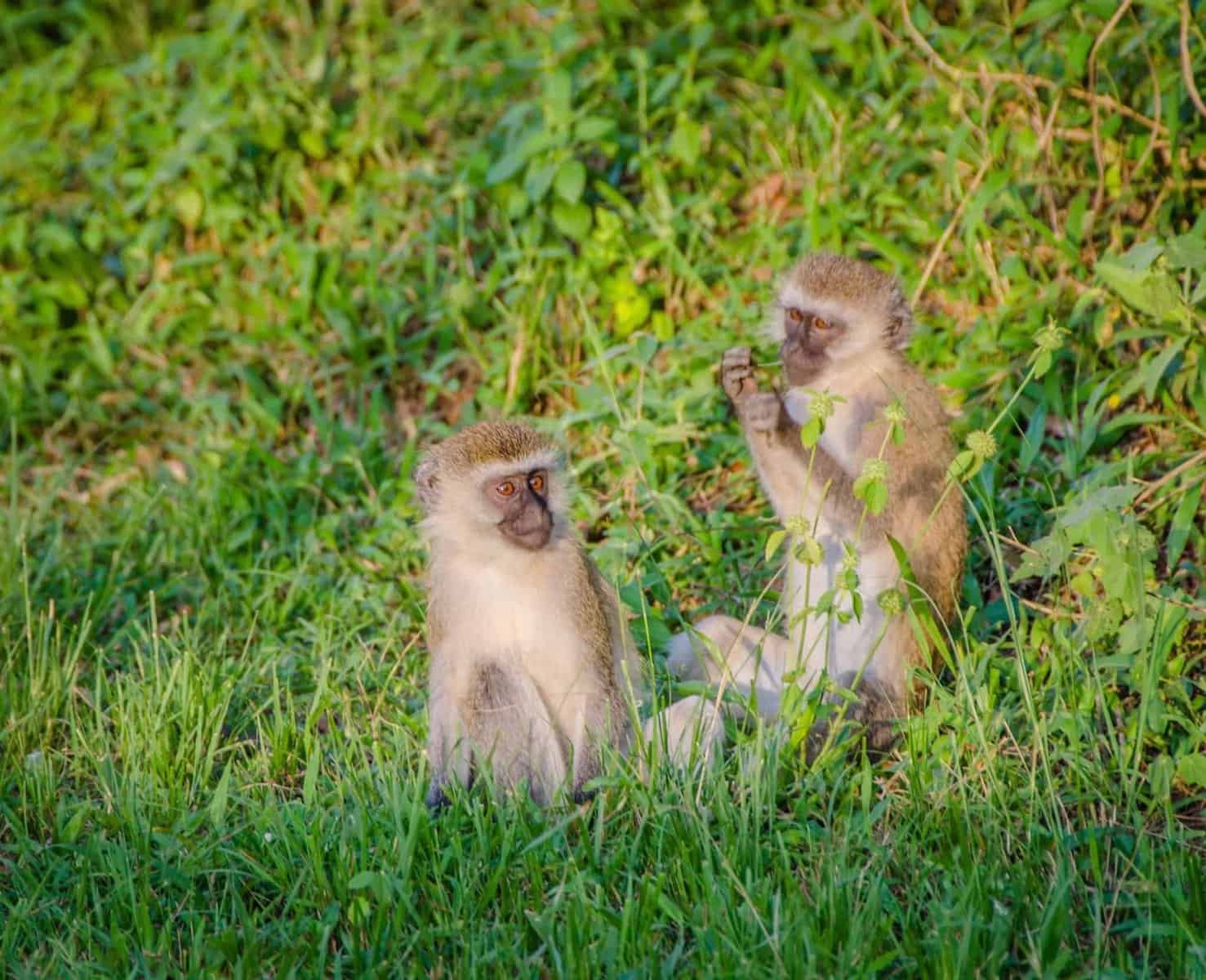
Monkeys greeted us at the gate as we drove in.

Around the corner we were closely watched by this zebra – one of many that we spotted as we made our way around one of the well-marked trails through the park.

We also went down to the lake itself – you can arrange boat trips here too as an optional extra.
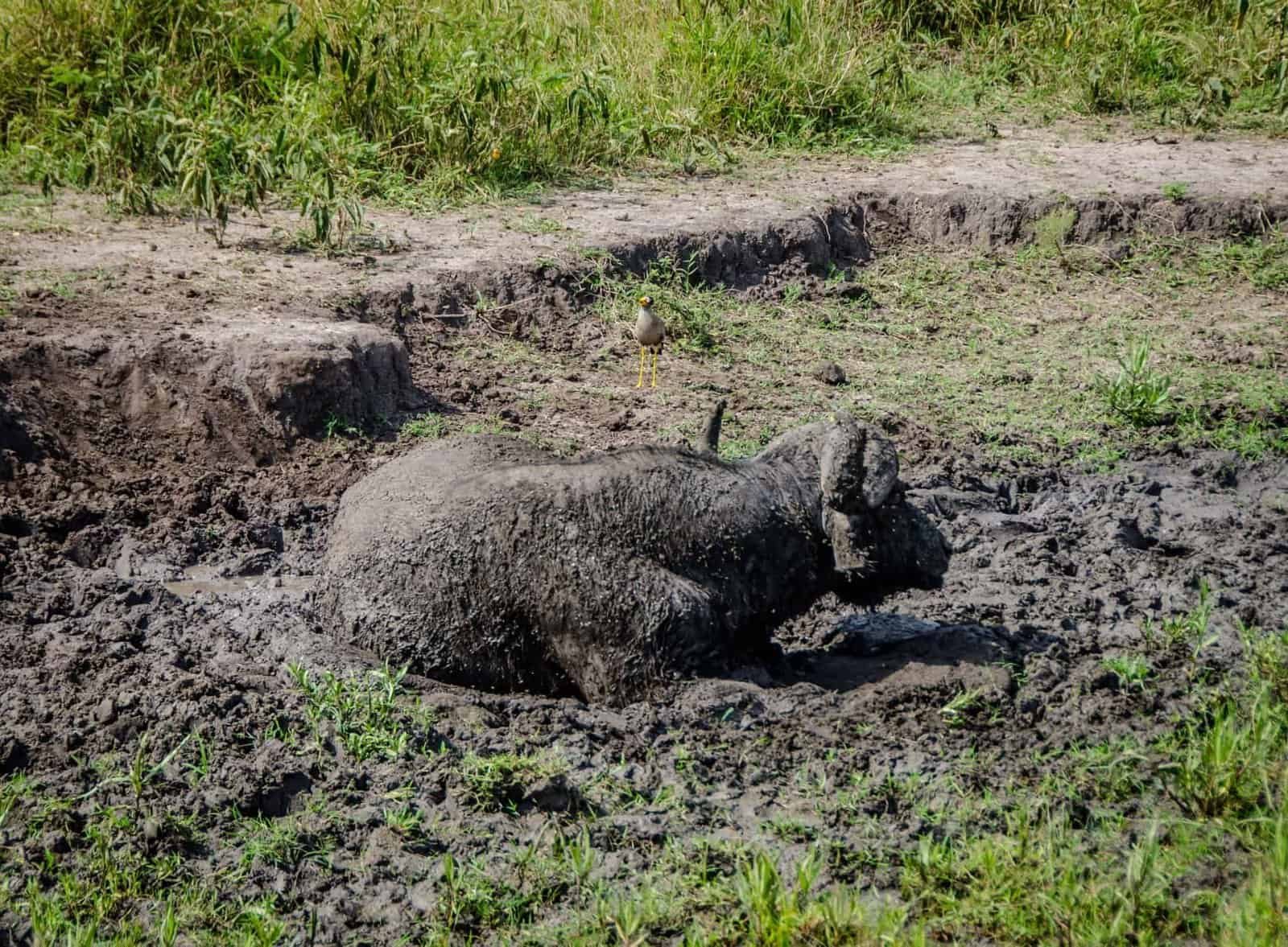
As we headed for our lodge we passed a buffalo having some mud treatment.
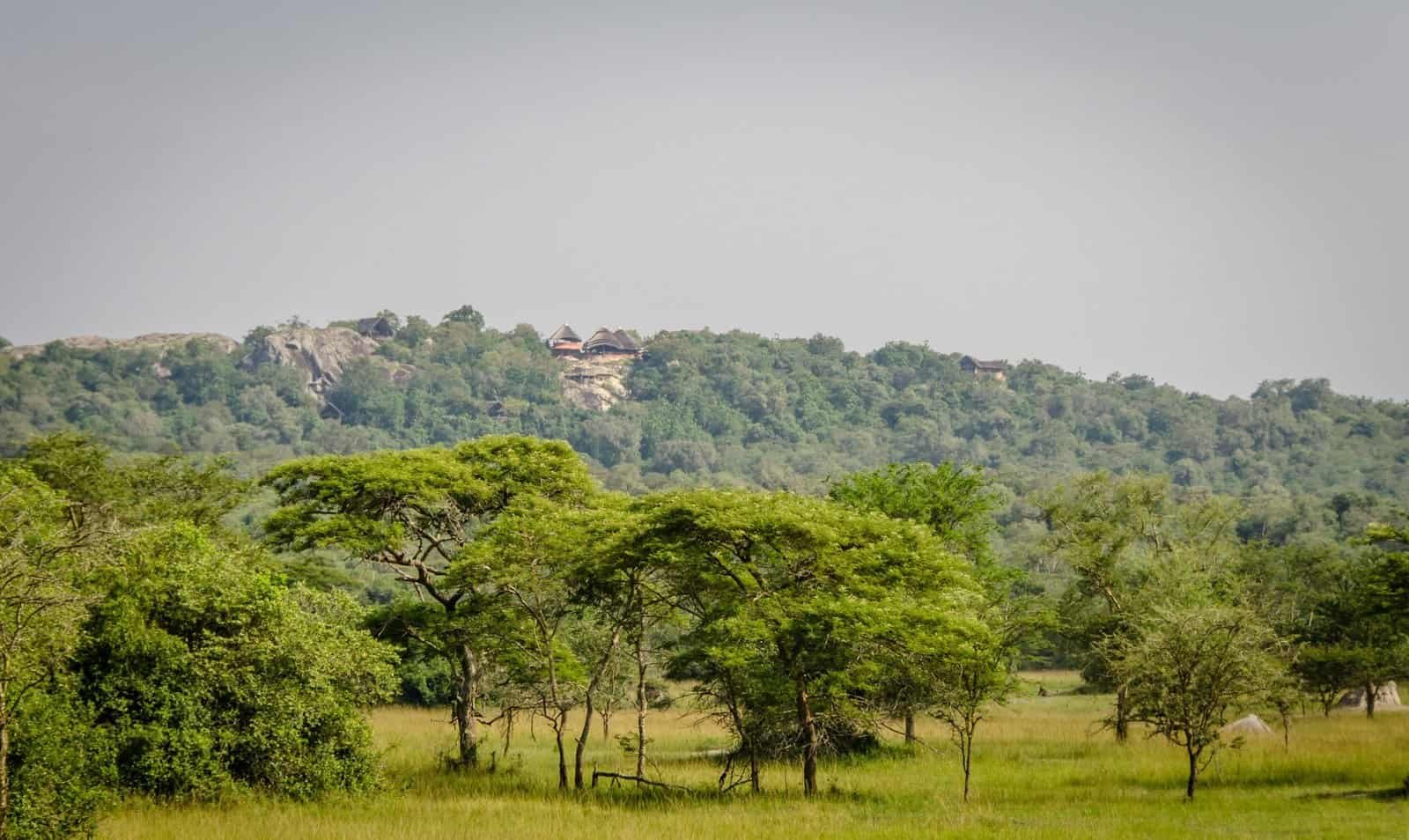
On our way to the park gate we caught our first view of Mihingo Lodge, which is located just outside the park boundary right on top of a huge rock outcrop (called a “kopje” in Africa). I had the distinct feeling that my last night in Uganda was going to be spent somewhere very special.
It turned out I was right.
Mihingo Lodge

Mihingo Lodge is one of the best places I stayed in Uganda, and yet again my one-night stay was nowhere near long enough. It is located in a private 97 hectare wilderness area right next to Lake Mburo National Park with amazing views.
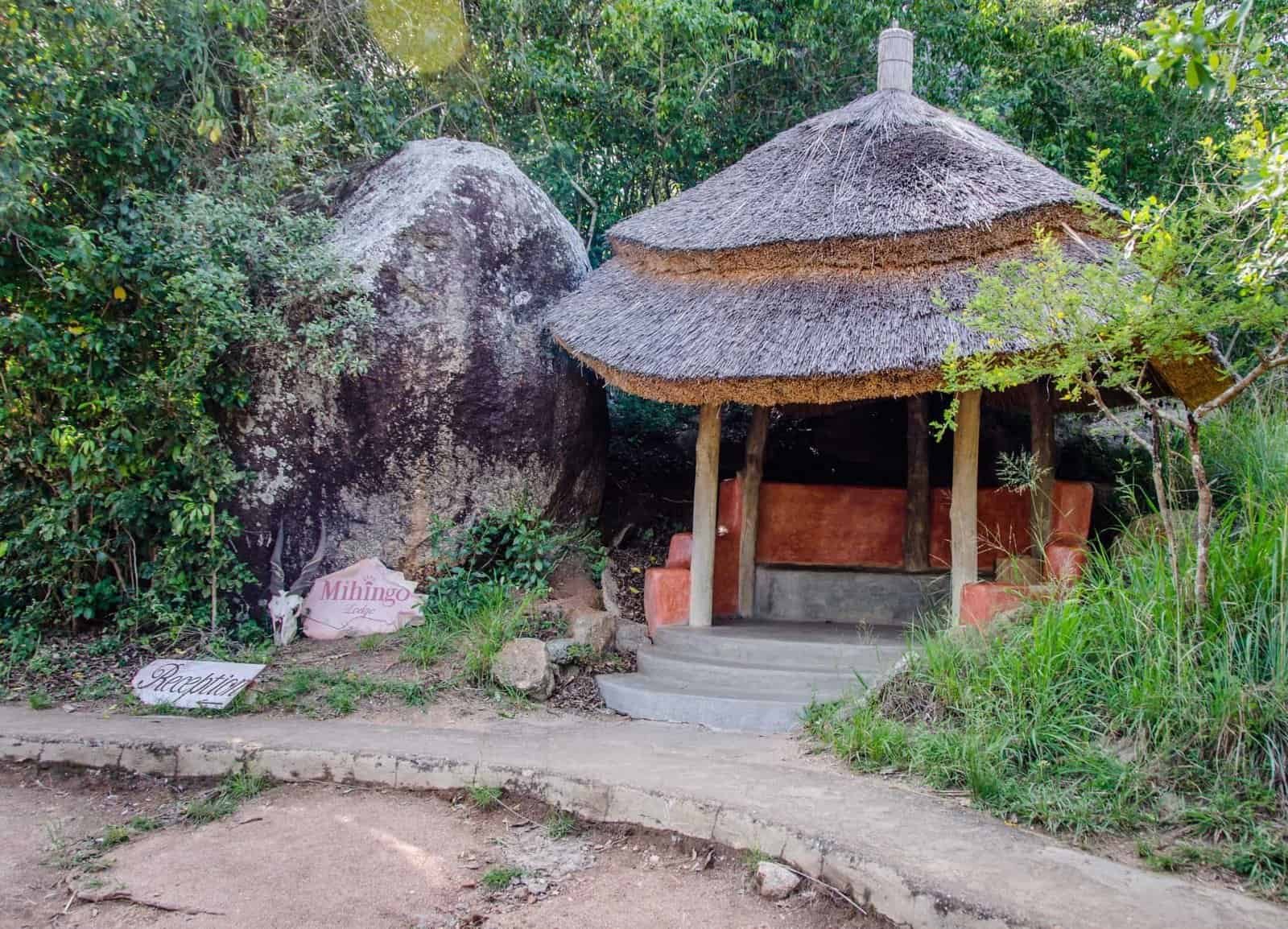
We parked up by the arrivals area where bags are dropped off and taken to the room. It’s quite a steep climb up to the main buildings.
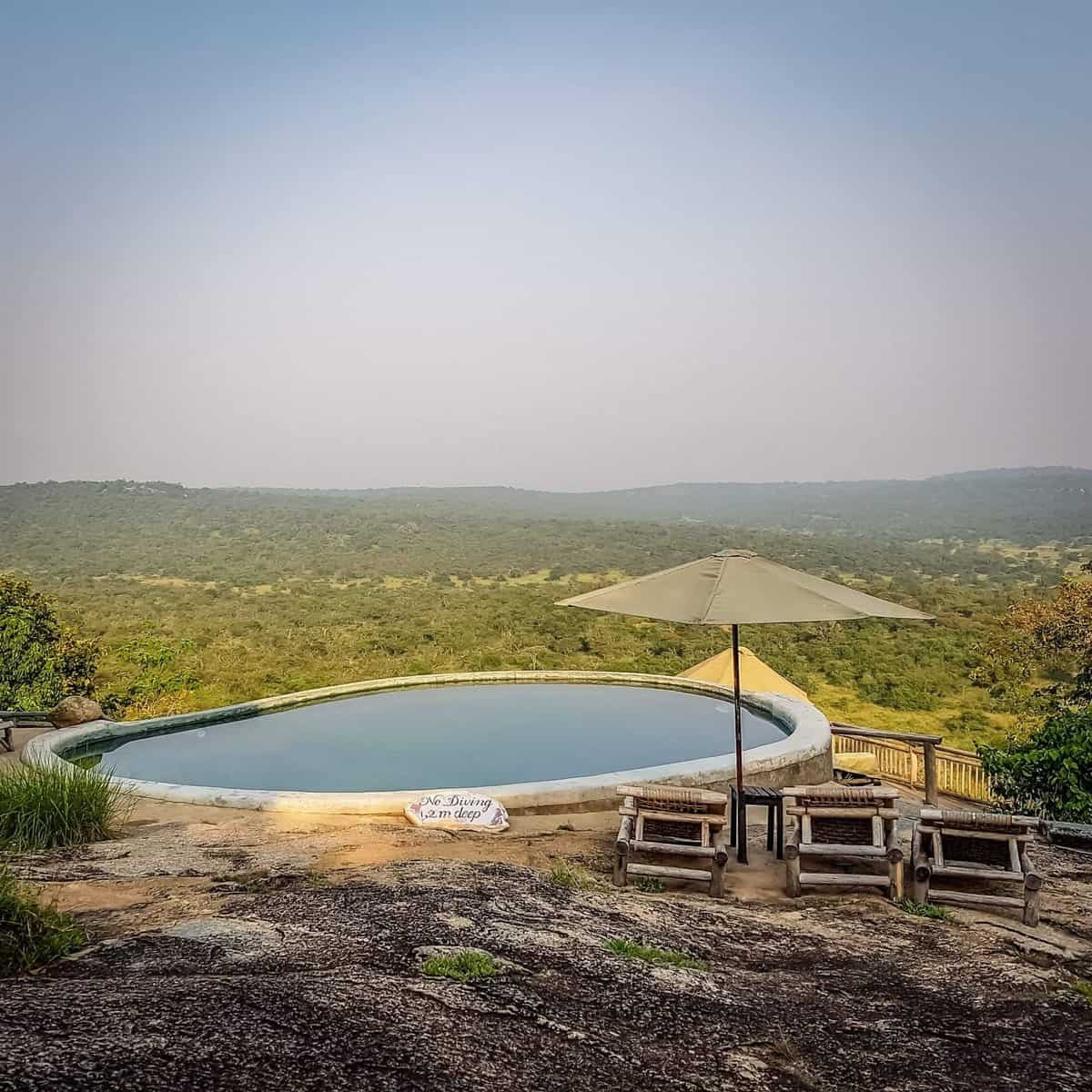
After receiving a cold welcome drink I took in the view to the west, straight over the national park. And that pool, eh? Again, I missed out on having a dip here, but I will be back to make the most of it.
The room
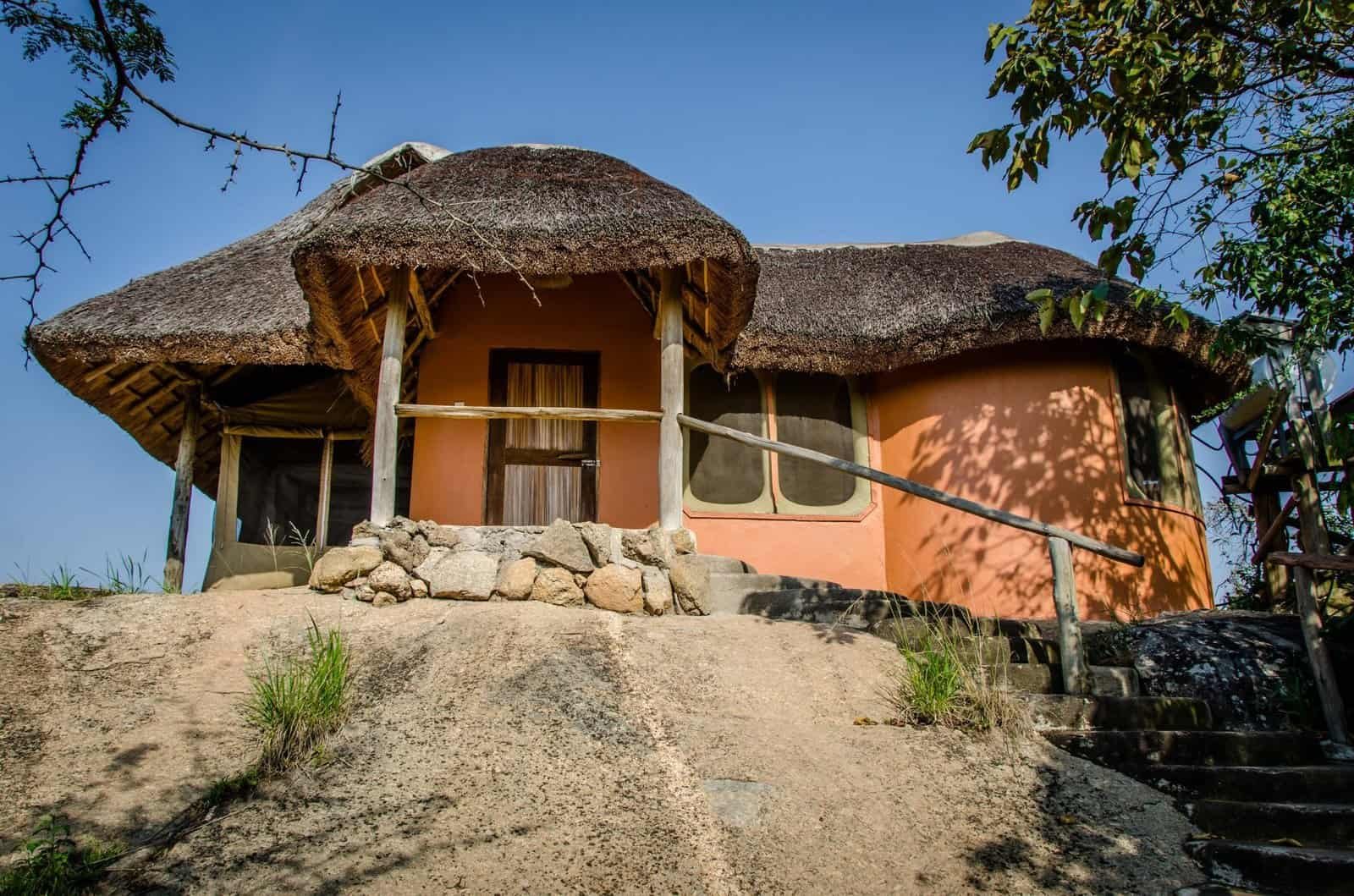
Each of the luxury tents is more of a chalet, with solid brick walls around most of the building but canvas walls for the bedroom, allowing the sounds of the wild to be heard clearly.

The standard is extremely high , with everything you could need.
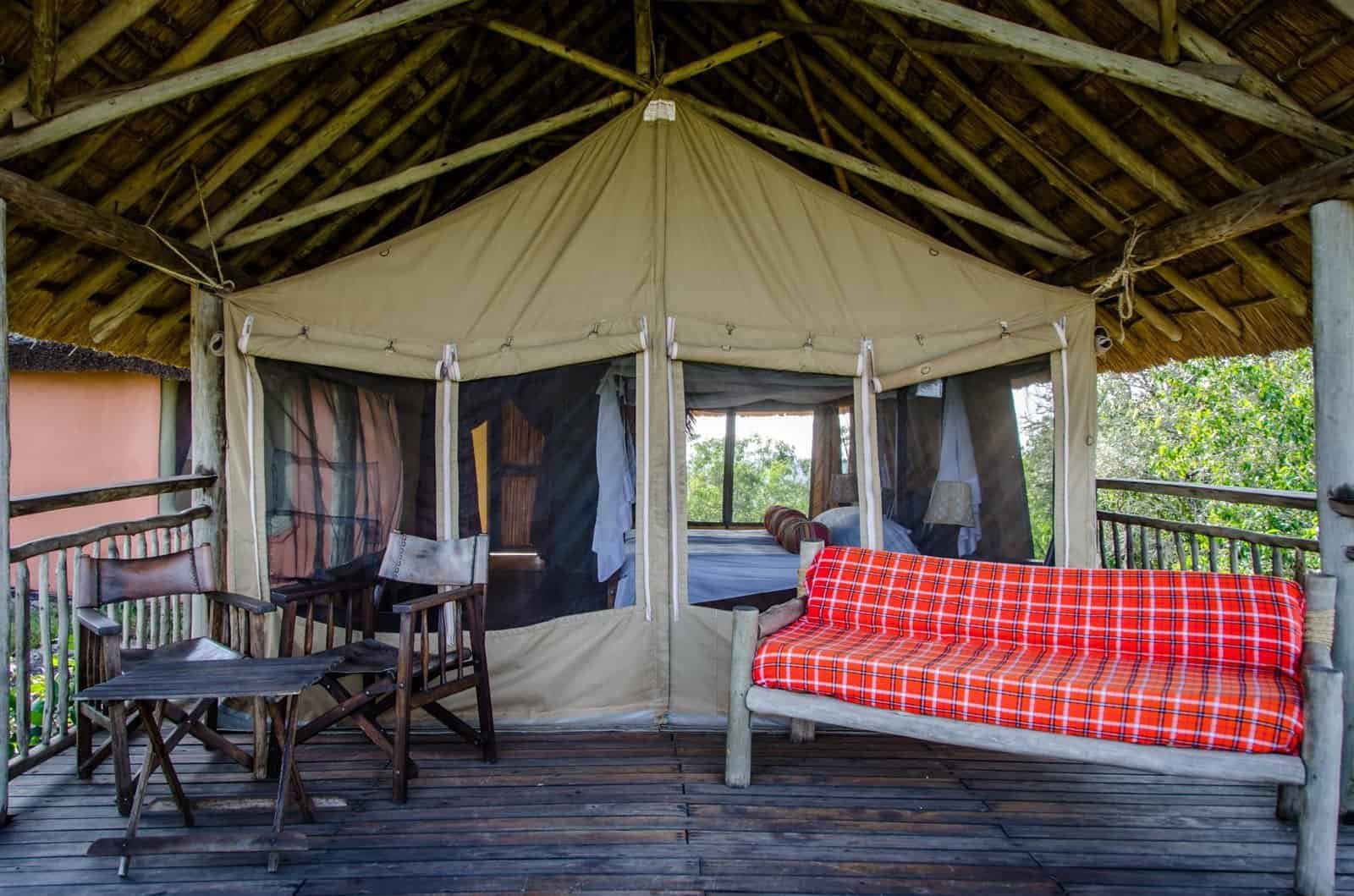
A large balcony is the perfect place to relax.

And the views from here are stupendous, with a 180 degree panorama eastward.
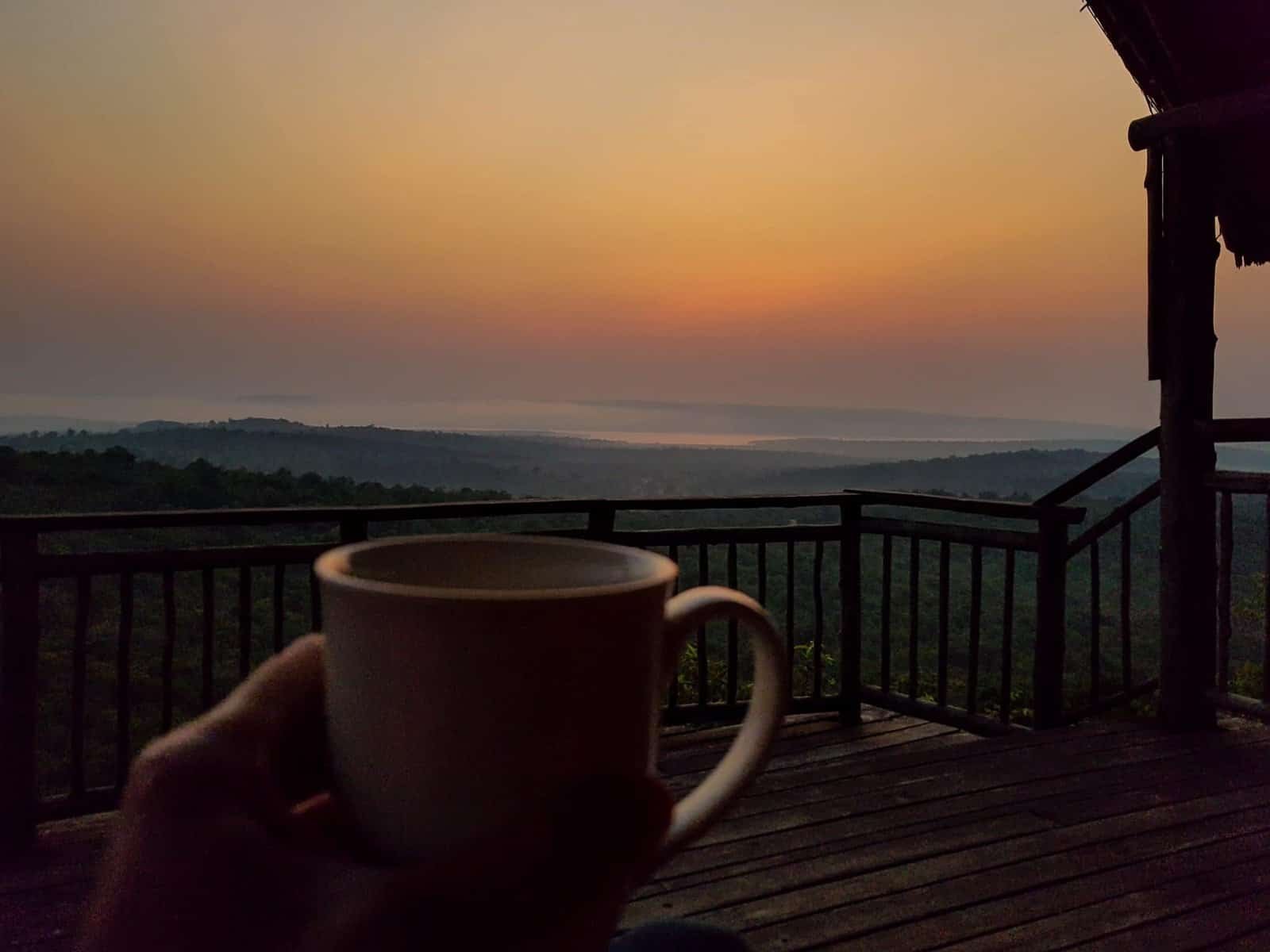
Yes, a sunrise cup of coffee (delivered to the room at an arranged time) is an ideal start to the day.
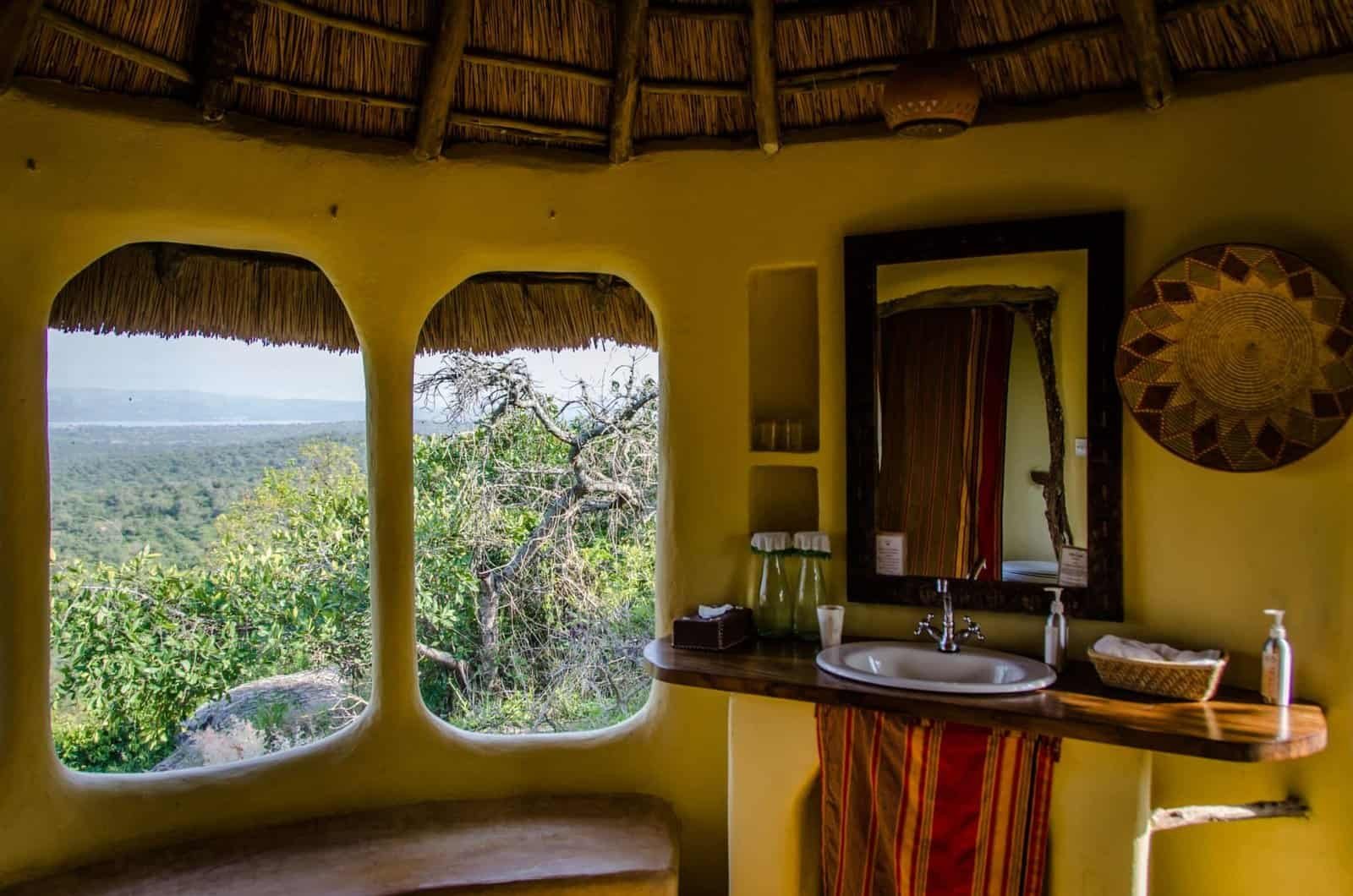
The bathroom is quite something, with its windows seemingly carved from the concrete walls.
Above is a video of my room.

The bar and restaurant area could hardly be better positioned. I ate dinner and breakfast here, and the food was as amazing as the views.
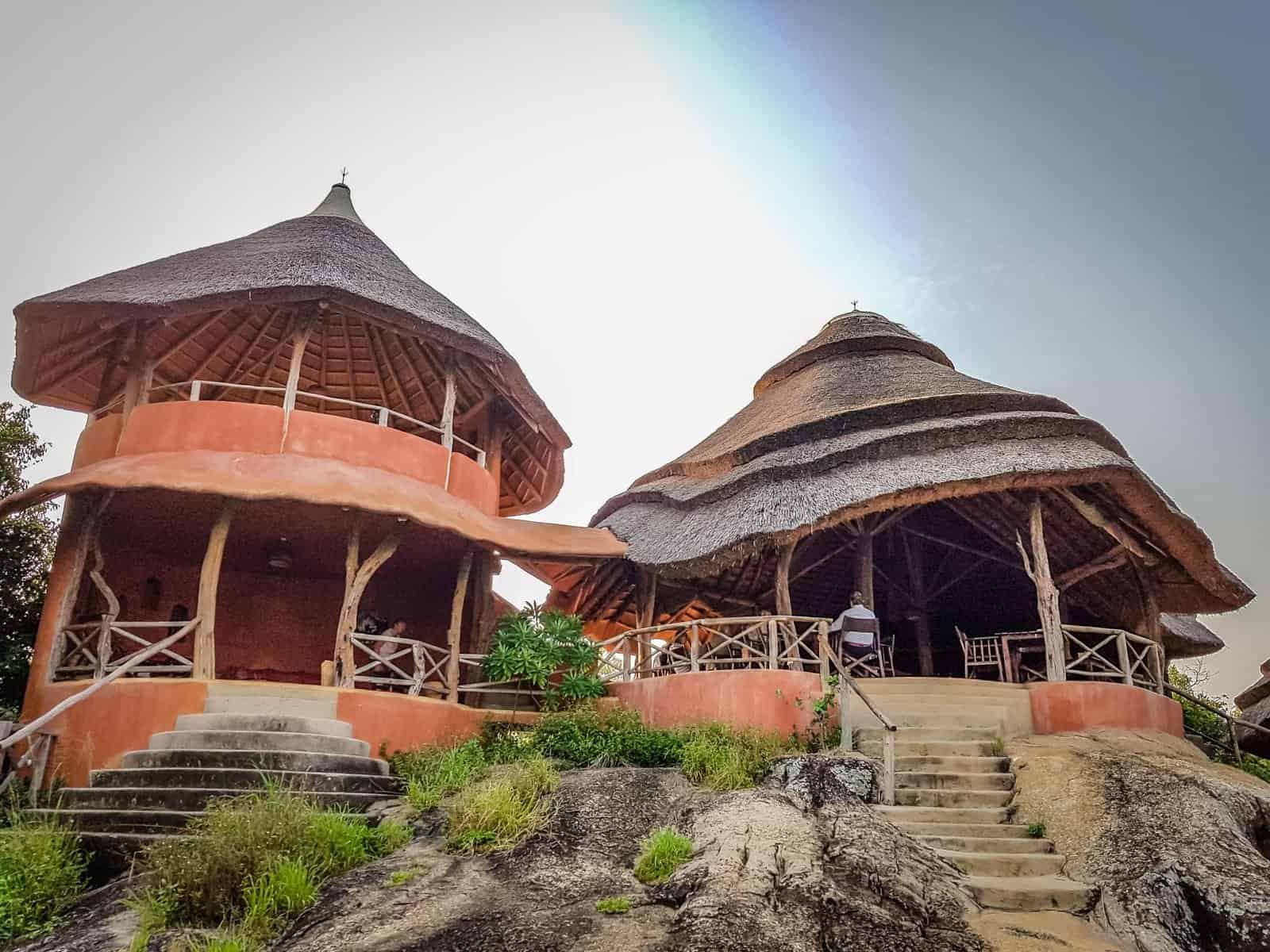
As well as the bar and restaurant area, there are a couple of lounges and a viewing deck so there is plenty of space to have some “me time”. I will cover more in the separate review but I would imagine even this brief description has whetted your appetite to visit Mihingo Lodge…
Before dinner we took a night drive (optional activity, extra cost), picking up a guide from the main gate to accompany us and help look for wildlife. There are several leopards in the area and we were hoping to spot one, but alas we had no luck this time.
It was still exciting though, driving in the dark with a high-power flashlight illuminating the eyes of various other animals before we were able to identify them.
Then it was back for a superb meal with the manager and my last night in Uganda came to a close, falling asleep with the sounds of wildlife and waking to the dawn chorus.
After breakfast the following day all that remained was to drive back to Entebbe airport for my flight home. After saying farewell to my driver, guide and now good friend Alfred with the promise to return.
My trip to Uganda far exceeded my already high expectations. I already knew about the friendly people and the main attractions of the gorillas and the chimps. But the landscape was an unexpected highlight – it is simply breathtaking. Add to that two national parks full of wildlife and the best leopard sighting yet, coupled with some superb accommodation options, excellent food and consistently great service, and it is hard to see why more visitors don’t come to the Pearl of Africa.
In summary, Uganda is something of an undiscovered gem beyond its primates – and I will be doing my best to spread the word and bring more people to the country, but tourist numbers will remain lower than most other safari destinations in Africa for many years to come, so what are you waiting for?
I hope this extensive trip report this has made you want to visit Uganda, the Pearl of Africa. All that remains is to contact me to arrange your dream trip, discuss options or just have a chat about Uganda. For an example tour following the same route as described in this report, click here.

